
[Source:
Martin James]
Halwill Gallery 1: c Early 20th Century - 1931 junction_old23.jpg) An early 20th century via across Halwill station and yard. The vantage point is the hill to the north-west of the station. The hillside in the foreground was later cut back to allow construction of the Torrington bay platform. A point to note is the then, shorter length of the up platform on the left. It was extended, presumably when the Torrington bay was constructed, but was to remain slightly shorter than the down platform opposite. A rake of goods wagons can be seen on the right but they are not necessarily all of LSWR ownership. LSWR wagon livery was a deep reddish-brown but photographic evidence suggests passenger-rated wagons, ie fitted with the continuous brake or at least through-piped, wore a variation of passenger stock livery. Not too much notice should be given to the cattle wagon at far right as the light areas on the bodyside may be the result of cleaning but these wagons were one type which was passenger-rated. A better example is the van seen beside the goods shed, it has a lighter coloured bufferbeam and under magnification can be seen to be vacuum piped. To the right of this van are two locomotives, the plume of steam indicating the position of that further back. The locomotive turntable is in the right background and largely out of sight in this view. The station platforms are oil lit but the lamp on the tall lattice post at the end of the platform is curious. It may have been gas, produced somewhere on-site, but this is highly unlikely. More likely is that it was on oil lamp, either wick or paraffin/pressure, of the type which could be winched up and down to and from the casement although there is no obvious evidence of any equipment for this purpose, nor does there appear to be a ladder. If it was oil, then its effectiveness on such a tall post would have been non existent. Later pictures show a similar lamp deeper within the goods yard but this was probably that seen here on the end of
the platform simply relocated. Copyright photo from John Alsop collection  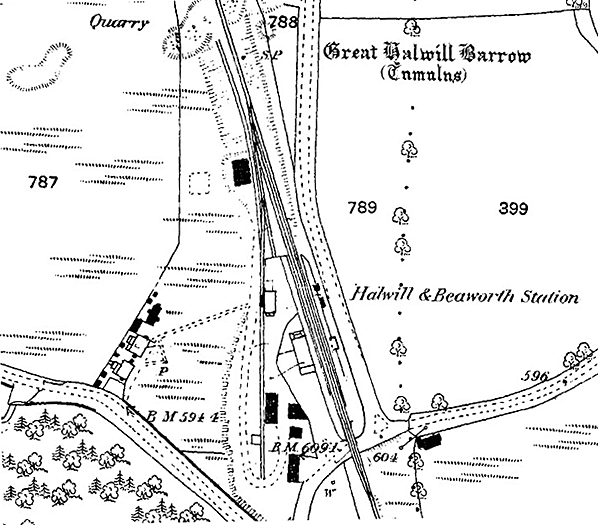
1885 1:2,500 OS map. When Halwill & Beaworth station opened it was just a wayside station and did not become a junction until 21July 1886 when the North Cornwall Railway opened its first section to Launceston. The station is seen in its original form here. The line was single track with a passing loop at the station to allow for two platforms as seen here. The main station building is seen on the down side where there is a forecourt with a small waiting room opposite. The goods yard comprises one long siding which runs alongside a dock and then passes the goods shed. Another long siding trails in from the slaughterhouse to the north of the station. A number of other buildings are identified at the south end of the yard. A third short siding terminates end on to the dock. Although not identified as such, the building at the north end of the down platform is the original signal box. A terrace of railway cottages are seen to the west of the station, a footpath runs from the cottages to the goods yard.
Click here to see a larger version. 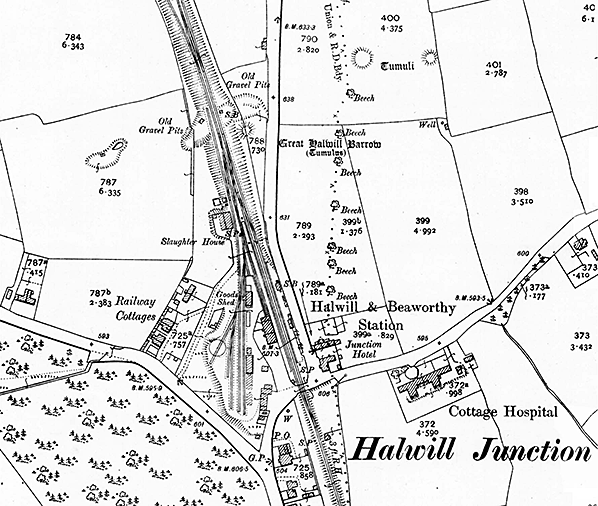
1906 1:2,500 OS map. With the arrival of the North Cornwall Railway Halwill became a junction station. Although the station name is now Halwill & Beaworthy the community that has built up around the station is itself called Halwill Junction. As well as new housing the community also included the Junction Hotel, a Post Office and the Cottage Hospital. The station building on the down side has been replaced with a number of small buildings located on the up side. The signal box which has been rebuilt is now identified. A new bay platform for North Cornwall line trains has been provided at the rear of the down platform at its north end. The goods yard has been expanded with the addition of two more parallel sidings and a third short siding. A 50-foot turntable turntable has also been provided in the west side of the goods yard. The entrance to the yard is unclear. Other buildings close to the entrance were probably merchants' offices. Three water cranes are shown but not identified, two at the north end of the down platform and one at the south end of the up platform. Click here for a larger version.
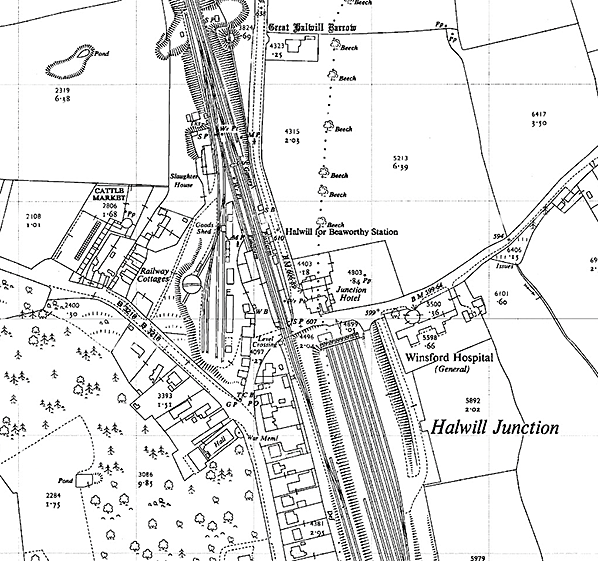 1954 1:2,500 OS map. The community of Hanwell Junction has continued to expand with some more housing and a cattle market which has opened to the west of the goods yard. A second bay platform for Torrington trains is now seen beyond the north end of the up platform. The original LSWR slaughterhouse built by the LSWR was replaced with a larger building by the Southern Railway in 1930. The entrance to the yard is now identified by a weighbridge (WM) located in the short station access road. The three water cranes (Wt Pt) are now identified. 8 sidings were built by the Southern Railway to the south of the station in 1943 to handle military traffic during the build-up to the Normandy landings. Click here for a larger version.
junction_old26.jpg) Another early 20th century view of Halwill and looking, left foreground, at the site of what was to become the Torrington bay platform. When compared to other similar early 20th century views one difference is apparent here; the tall lattice post lamp on the end of the down/bay platform has disappeared. It is suspected of being relocated into the goods yard but its location there is hidden, in this view, by the pitched-roof slaughterhouse on the right. The slaughterhouse was rebuilt by the Southern Railway in 1930. At far right can be seen the rarely photographed water tower. This supplied water to the water columns on the platforms, there are two in this view but there was later three. Just beyond the goods shed a locomotive stands while a train waits in the bay platform. In both cases the locomotives cannot be identified. This and other elevated views looking in the same direction illustrate well the gradient between Halwill and Ashbury, the next station along the line to Meldon Junction. It was this gradient which was responsible for the 1905 accident and partly responsible for the 1944 accident, both being briefly described below. Note the large an irregularly shaped dock with one siding terminating end on. Copyright photo from John Alsop collection 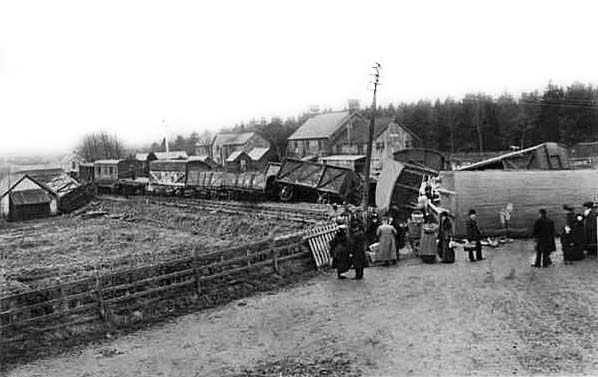 The quiet rural location of Halwill station was witness to a number of serious accidents. One occurred on 6 February 1905 and two in 1944 during the Second World War. These two photographs show the wreckage of the 1905 accident. A goods train approaching Halwill from Ashbury, on the Okehampton line, became divided on the downward gradient approaching Halwill. This was probably the result of snatching couplings which, at that time on the LSWR, were quite feeble and eventually the heavier GWR type became standard. Part of the job of a goods train guard included applying the brake in his van to assist the slowing of goods trains which were wholly or partially unfitted (not fitted with the continuous brake) depending upon the types of wagon and also to keep couplings taut for the very reason of preventing snatching. As the front portion of the 1905 train approached Halwill it slowed and on reaching the level crossing the out-of-control rear portion rammed into its rear. The guard, in his van at the rear of the runaway portion, would have been able to do little to prevent the collision. The result was the death of a number of pigs, injuries to two railwaymen and 25 damaged or wrecked wagons. The locomotive involved is not known. The subsequent report on this accident is now held at The National Archive. Details of the 1944 accidents are vague, probably because of conditions prevailing at the time.
Photo from John Mann collection 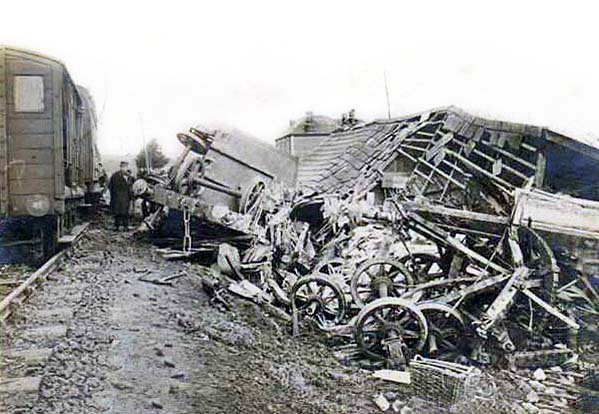 A locomotive or train, quite which is unclear, was accelerating hard away from Halwill in order to tackle the same gradient, rising in this direction, towards Ashbury. Beyond the level crossing, wrongly set points diverted the train or locomotive onto a siding whereupon it demolished the buffers and ended up on, reports say, the Beaworthy Road. Recovery involved two N15 and one S160 locomotives which required dispensation to cross Meldon Viaduct in order to attend the scene. The N15 was a 4-6-0 tender locomotive better known as the 'King Arthur Class'. The S160 was a wartime 2-8-0 of the USATC (United States Army Transportation Corp) and which saw service in many countries during and post war. Very American in appearance they were poorly designed, especially the firebox, and were prone to explode. Nevertheless many continued in service for a considerable time after the war, but not in the UK as all bar one were sent overseas following D Day. The exception was a single example retained by the army at Longmoor. The final examples in service are thought to have been on the Polish State Railways (PKP) where they survived into the late 20th century. One 'King Arthur' survives in preservation as do a number of the S160's, including some re- imported into the UK. The gradient between Halwill and Ashbury responsible for the 1905 accident and arguably the aforementioned 1944 accident can be seen on the elevated views across Halwill station elsewhere in these pages. The second 1944 incident involved a locomotive overturning as a result of enemy action but no other details are known at the time of writing. Details of incidents resulting from enemy action were kept quiet, partly for morale reasons and partly to hide from the enemy any details of their successes. Such incidents would, of course, be known to local people but the public as a whole were encouraged to keep quiet. This silence was the purpose of the well known 'Careless Talk' wartime posters and cartoons but this of course applied generally and by no means only to 'incidents' on the railways.
Photo from John Mann collection junction_old24.jpg) A rather splendid postcard view of Halwill station from no later than July 1909, this being its postmark date. By this time all but the Torrington line had reached Halwill and the signal box will be that provided for the North Cornwall line opening but before its north end extension. Note the superb signals, mainly of wood but with iron spandrels, railings, ladder and LSWR finials. They probably related, at this time, only to the down platform and bay rather than to the North Cornwall junction. In the bay, two LSWR coaches are seen, probably 6-wheelers, while wagons can be seen at the goods shed. The most obvious wagon is of the type used for salt, sand, lime, clay etc. It appears to be sheeted rather than roofed. Several of the stations oil lamps can be seen. The people posing for the camera are mainly, if not entirely, railway staff of various grades. Today camera ownership is commonplace but until the mid 20th century many people lucky enough to own a camera made do with something like a 'Box Brownie' or if they were a little more 'upmarket' perhaps a 35mm camera of German origin. Back in 1909 things were very different. Most photographers were semi or wholly professional and cameras were clumsy affairs requiring sturdy tripods or some other form of sturdy mounting, exposure times were relatively long, lighting conditions were absolutely crucial and the medium was glass slides. Furthermore, photographers had to judge exposure times and shutters were by and large manually operated. All these factors necessitated the setting-up for a photograph being a well planned operation and thus the people seen in this view would have been deliberately positioned and required to stand totally still for several seconds - all very different to today's ability to take photographs instantly and at whim. It should also be remembered that over a century ago many people, especially in rural areas, had never seen a camera in action so scenes such as this would have been very much memorable events. On the left, note the point rodding and signal wires disappearing beneath the platform and re-emerging from the end of the ramp. When the Torrington bay was constructed these rod and wire routes were covered by a wooden walkway for the benefit of drivers attending to their locomotives.
Copyright photo from John Alsop collection junction_old25.jpg) A postcard view of Halwill station looking north with the level crossing behind the camera. If it were not for the nameboard, which does not yet announce details of connections, the location would be difficult to recognise due in no small part to the bushes and trees. The postcard is postmarked July 1909 but the photograph was probably taken a little earlier. The locomotive is LSWR Adams 395 class 0-6-0 No.442, a class nicknamed 'Jumbos' (not to be confused with the Caledonian Railway locomotives of the same name). No.442 was built by Neilson, Reid & Co. in 1883 and in 1903 a Drummond 4-4-0 was built and which was also numbered 442. Thereafter 395 class No.442 went on the duplicate list as No.0442. Therefore this photograph in theory dates from no later than 1903, depending upon when the LSWR actually got around to applying the renumbering, but is probably from 1905, the year the headcode displayed on No.442 was introduced. This headcode tells us the train was a Padstow - Exeter service. The 395 class were somewhat odd looking machines due to their raked back smokebox fronts similar to that found on the Metropolitan and District 4-4-0T's. During WWI several members of the 395 class were sent abroad, some ending up in the Middle East where they continued in service for many years following the end of hostilities. No.442, however, remained at home. After a lengthy career of no less than 74 years she was finally withdrawn in August 1957 as British Railways No.30578. This demonstrates very well the rugged simplicity of 0-6-0 tender locomotives, many types originating in Victorian times surviving well into BR days. The group on the down platform appears to comprise mainly children. As described elsewhere, a century or more ago photography was something of an event and people posed rigid for the camera but the party on the down platform are rather blurred, suggesting disinterest in the camera. There is probably a train due in the down direction, which would explain the signal being 'on' against No.442. Note that the signal has a quite ornate lattice post whereas signal posts at the other end of the station at this time were largely of wood. It is likely the lattice post has replaced an earlier wooden example.
Copyright photo from John Alsop collection junction_old27.jpg)
Halwill station has a 'Colonel Stephens' look about it in this view taken on a wet day in June 1926, not long after the General Strike of that year. The mixed train at the down platform comprises two passenger coaches, some goods wagons and vans, plus another passenger brake at the rear so presumably the goods vehicles are either fitted (braked) or through-piped. The locomotive is 460 class No.0471. This was one of the batch built by Robert Stephenson & Co. in 1884. Another member of the class can be seen in the goods yard, this time one of the Neilson batch with Adams style square cab windows and also dating from 1884. No.0471 will depart Halwill and branch off onto the Launceston and Wadebridge line. In the bay platform a Drummond M7 0-4-4T sits with a short goods train or perhaps in the process of forming a goods train. Assuming the headcode disc visible is the only one carried, it is the code for Bude. Also visible are the dock, goods shed and a large part of the goods yard. The yard saw a number of alterations over the years and a 50ft locomotive turntable was also provided; it is to the right of this view but largely out of sight. Note the lamp on the tall lattice post, right background. What this was fuelled by is not known but the platform lighting was certainly still oil at this time and would continue to be so for a number of years.
Copyright photo by HC Casserley 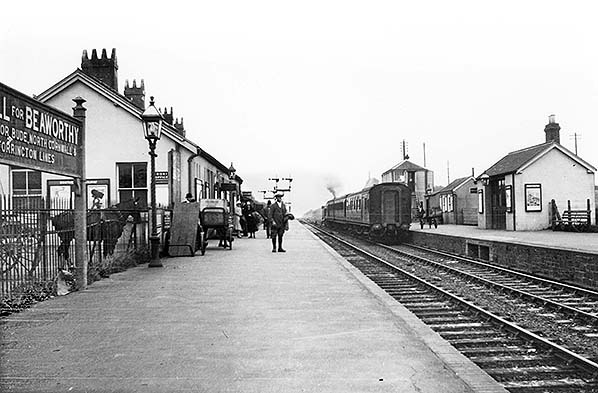 A charming scene looking north along the down platform of 'Halwill for Beaworthy' station in 1931. As always, the station building is neat and tidy while various Southern Railway signs and noticeboards can be seen. Oil lamps with their typical glass chimneys can be seen in the casements. Behind the railings on the left what appears to be a pony gig is seen waiting. The running-in board at far left is in its post-1925 form. Passengers are informed that they should 'Change for Bude, North Cornwall & Torrington Lines'. As many trains arriving at Halwill would have continued to one or other of the listed destinations, one wonders how many people already on a train would have been confused and alighted unnecessarily. The use of the 'North Cornwall' name is a little odd as one might have thought 'Launceston' or 'Wadebridge' to be more informative but then the line was known as the 'North Cornwall Line' throughout its life so perhaps the choice of name caused no problems, at least not for local people. The various changes of name affecting Halwill station and its signal box over the years are well known but 'Halwill for Beaworthy' was often quoted, including on maps, as 'Halwill and [or &] Beaworthy'. Regardless of how the name was presented, the station was not especially convenient for either settlement. The train at the platform comprises an ex-LSWR 2-car set strengthened with a Maunsell brake-end coach, probably a brake third. The locomotive cannot be identified and all that can be ascertained is that it is coupled smokebox-to-train. A charming scene looking north along the down platform of 'Halwill for Beaworthy' station in 1931. As always, the station building is neat and tidy while various Southern Railway signs and noticeboards can be seen. Oil lamps with their typical glass chimneys can be seen in the casements. Behind the railings on the left what appears to be a pony gig is seen waiting. The running-in board at far left is in its post-1925 form. Passengers are informed that they should 'Change for Bude, North Cornwall & Torrington Lines'. As many trains arriving at Halwill would have continued to one or other of the listed destinations, one wonders how many people already on a train would have been confused and alighted unnecessarily. The use of the 'North Cornwall' name is a little odd as one might have thought 'Launceston' or 'Wadebridge' to be more informative but then the line was known as the 'North Cornwall Line' throughout its life so perhaps the choice of name caused no problems, at least not for local people. The various changes of name affecting Halwill station and its signal box over the years are well known but 'Halwill for Beaworthy' was often quoted, including on maps, as 'Halwill and [or &] Beaworthy'. Regardless of how the name was presented, the station was not especially convenient for either settlement. The train at the platform comprises an ex-LSWR 2-car set strengthened with a Maunsell brake-end coach, probably a brake third. The locomotive cannot be identified and all that can be ascertained is that it is coupled smokebox-to-train.Photo from John Mann collection Click here for Halwill Gallery 2: - 1930s - April 1963
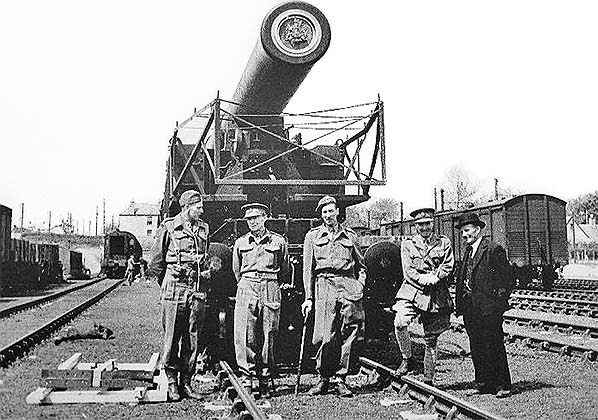 In preparation for the Second World War, 8 sidings were laid on land to the south of Halwill station and on the up side. The reference point in this photograph is the Junction Hotel, left background. Seen here are army personnel, including two officers, and an official either from the Southern Railway or the War Department, posing for the camera in front of a rail-mounted gun. On the left one of the two diesel shunters used with the gun can be seen. For more details and pictures click here.
junction_old28.jpg) The Torrington bay at Halwill in September 1956. The locomotive, here being attended to by the driver, is an unidentified LMS-designed Ivatt 2-6-2T. A number of these useful little locomotives pottered around the Southern and were supplemented by the BR Standard versions. The train comprises a single Bulleid coach, perfectly adequate for the toddle to Torrington. The wooden walkway was for the benefit of locomotive crew but they could be quite slippery in wet weather as would appear to be prevailing in this view. The headcode was that for Bude so assuming the train was indeed going to Torrington then the same code must have applied to both lines; a very unusual situation where two separate routes met, as at Halwill. The disc position shown is known to have also applied to the Barnstaple Junction - Torrington section. Towards the left the bay's running-in board which displays 'Halwill Junction' can be seen. This name also once applied to the signal box whilst the main station is thought to have never been given the 'Junction' name insofar as its nameboards are concerned. At least 'Halwill Junction' is rather more accurate than 'Halwill for Beaworthy' as it related to the settlement of Halwill Junction which grew up adjacent to the station. No doubt the name of the Torrington bay had its origins in the line's independence from the Southern Railway. At the down platform of the main station a Drummond T9 is about to depart for Padstow and it will branch off westwards at a point to the right of the photographer but out of view from this angle.
Copyright photo by RM Casserley junction_old29.jpg) September 1956 and Drummond T9 No.30709 waits at Halwill with a train from Padstow. It is heading for Okehampton and perhaps Exeter. At the rear of the train but shrouded in steam is another locomotive, indicating that something is being attached to No.30709's train. See picture below of this train departing. The person standing on the track is a shunter complete with pole. Shunters poles had a hooked end and were used to couple and uncouple stock. This was heavy work but once the knack of swinging the coupling was acquired it became second nature. Once the drawbar coupling was attached and slack taken up, if a screw coupling, it was then necessary to duck beneath the buffers and connect the pipework; vacuum; air; steam as applicable, set up the gangway connection, if any, and then open the relevant cocks and conduct a brake test. All this done, the tail lamp would be positioned and if all was well it was away we go. On the modern railway and insofar as passenger stock is concerned, the shunters pole is now a very rare sight. It will be noticed that the level crossing is open to the railway and in all probability had been so for several minutes. Such delays to road traffic were not uncommon and do still occur, the situation being dictated by interlocking between signals, points and level crossing which can be done only in a certain sequence. Back in 1956 road users, and there were much fewer of them than today, were more used to the gated level crossings which then proliferated and were in much less of a hurry. Halwill up starter signal is just out of view to the right. On the down side of the station, the bay platform is occupied by goods wagons and this appears to have been a frequent occurrence. The probable reason was the simplification of attaching and detaching wagons to or from through trains.
Copyright photo by HC Casserley junction_old32.jpg) Taken a few minutes after the previous view (above) showing No.30709 and the shunting operation, this view shows the same train on its way south from Halwill. What had been attached was two Conflat wagons with containers, these being just visible on the rear of the train. Conflats were 4-wheel flat wagons upon which were mounted various types and sizes of container. Readers of a certain age group will remember British Rail branded the service 'Door To Door' for many years and that is precisely what it was. Containers were collected from the despatching customer by road vehicle, typically one of the various models of Scammell lorry with 3-wheel tractor unit, delivered to the local goods yard and loaded onto Conflat wagons. At the end of the rail journey containers would be delivered to recipients by the same means. Anybody, from private individuals to commercial organisations, could and did use the service but British Railways never considered the service profitable. In many ways the service was the forerunner of the Freightliner trains as introduced by Dr Beeching. Conflat wagons later found use as 'runners' for smaller diesel shunters such as Class 03 which could not be relied upon to operate track circuits on their own. The locomotive which attached the wagons at Padstow has probably retreated to the sidings out of view to the right.
Copyright photo by HC Casserley junction_old30.jpg) Still at Halwill on a wet and steamy day in September 1956 and viewed from the Torrington platform, by now vacated by the Ivatt tank and its single carriage train. Some distance behind the camera was the runround loop for the Torrington branch, this being operated via a ground frame unlocked from the signal box but it is unclear if this was done electrically or by a key obtained from the box or by key attached to train staff. There was a connection from the Torrington branch to the up main line and trailing in the up main direction. At the up platform is what appears to be a BR Standard tank locomotive attaching a carriage to a train bound for Okehampton and beyond. The locomotive is displaying the headcode for the Torrington branch. At the down platform a T9 stands with a Padstow bound train but is it thought not to be the same train as seen in another view taken on the same day. On the right a better view of the Conflat wagons and their containers is offered while the down bay platform is occupied by a rake of cattle wagons. The station has electric lighting with familiar Southern style standards as manufactured at the Southern Railway's Exmouth Junction concrete works. These were probably installed at Halwill in the mid to late 1930s.
Copyright photo by HC Casserley junction_old31.jpg) On the same damp day as other September 1956 views, we again see the train in the Torrington bay at Halwill but even from this angle the Ivatt tank still cannot be identified thanks to its filthy condition. At the down platform a Drummond T9 is signalled away for the North Cornwall line to Padstow. As if to make the Ivatt feel at home, the T9 is also filthy but a larger version of this view suggests it is No.30717. This locomotive was a long-time resident of various sheds in the area, including Wadebridge, and was at Exmouth Junction from 1952 until withdrawal in the summer of 1961. On the right some Conflat wagons with containers can be seen.
Copyright photo by HC Casserley 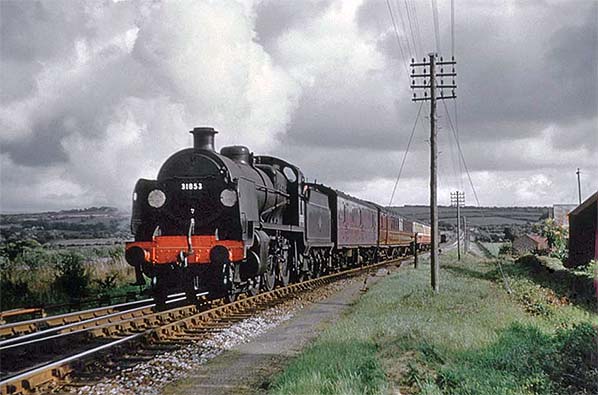 Believed taken in 1959, Maunsell N class No.31853 has descended the gradient from Ashbury and will shortly pass over the level crossing and arrive at Halwill. She is negotiating the points for the two platform roads. No.31853 was transferred to Exmouth Junction (from Bricklayers Arms) in June 1959 so that would explain her relatively clean condition, Exmouth Junction's allocation usually being in filthy condition. There exists a perhaps understandable assumption that any locomotive-hauled passenger train carrying two headcode discs at Halwill is the Atlantic Coast Express (ACE) but this could not be more wrong. The headcode, as seen here, applied to all passenger trains between Exeter and Padstow, Okehampton and Padstow or Halwill and Padstow in either direction. No.31853 could be working a portion of the ACE but it is more likely to be an Exeter or Okehampton - Padstow local which will divide at Halwill with the rear portion being forwarded to Bude. In the background beyond the rear of the train, two unidentified vehicles are stabled at the end of rarely photographed siding on the up side of the line. It was here where in 1944 a points error caused a locomotive, which was getting up speed to storm the gradient, to demolish the buffers and end up on the Beaworthy Road. The train behind No.31853 is of particular interest. The first vehicle is a CCT van and further back are a couple of carmine and cream liveried Bulleid coaches while at the rear of the train is what looks like another van. It is the second and third vehicles in maroon livery which are interesting for they are an articulated pair. At first glance one may think they are either set 513 or 514, the sets converted from former steam railmotors and one, at least, of which was at Exmouth Junction for a while but this was in 1951 - 2, long before this photograph was taken. Notwithstanding what appears to be a lavatory compartment in both cars, the set looks more like one of the ex-LNER Gresley steel-panelled articulated pairs which comprised a brake third and a lavatory composite. If so, then quite what it was doing in the West Country is a total mystery. Perhaps a reader who is expert in coaching stock will be able to provide more information.
Photo from Ted Burgess collection 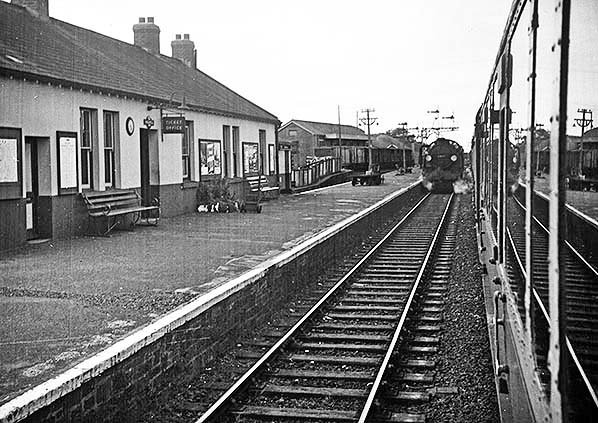 The view from a carriage window at Halwill on an unknown date in 1961. Precisely what is happening is something of a puzzle and not helped by knowing only the year. An enlargement of this photograph tells us the station clock is showing 5.29 and this will be PM. Bradshaw for 6 March - 2 April 1961 suggests the train on the right will be the 3.13pm ex-Padstow which arrived Halwill 5.20 and departed 5.26 for Exeter St David's (Mon - Fri) or Okehampton (Sat only). However, the length of the train and the N class locomotive on the down line suggests a Bude portion has been attached but the Bradshaw edition quoted shows no service arriving from Bude at this time. Thus whilst the train on the right can be assumed to be the 3.13pm ex-Padstow, the photograph most likely dates from the 1961 summer timetable period. The N class locomotive appears to be No.31847 but it is by no means clear. It is interesting to note, or horrifying depending upon one's point of view, that the 49¾ mile journey between Padstow and Halwill occupied an average of two hours. Such were the problems with single track routes with numerous intermediate stations and passing loops. Admittedly some journeys are not a great deal better today but back in the 1960s when government propaganda led people to believe the private car was the future it is no wonder, especially when intervals between train services were long, that people abandoned the railways and turned to road transport. In fairness, the roots of this problem harked back to when the railways were built during the Victorian era, a time when travel over any distance involved no alternative other than horses or on foot but that, as they say, is another story. Nevertheless, given the slow and infrequent train services it is possibly thanks only to the Atlantic Coast Express and the then pro-British holiday trade that Halwill remained open for as long as it did.
Photo from DK Jones collection junction_old33.jpg) A relaxing moment, for some, at Halwill's Torrington bay platform in June 1962 as the crew of Ivatt 2MT No.41294 take a break on the platform bench. The Ivatt was a resident of Barnstaple Junction shed at this time, which is also where the crew would have been based. By virtue of the line to Torrington being a light railway, the hopelessly infrequent services to and from Halwill were leisurely affairs taking not far short of one-and-a-half hours for the journey of a little over twenty miles. There were also some additional and equally infrequent services between Torrington and Petrockstow, these taking over half an hour to cover the eight miles. In the background an N class locomotive is about to take the North Cornwall line towards Launceston and Padstow with at least two parcels vans in-tow. Shadows tell us the photograph was taken in the morning, which means the departing train will be the 10.28 (ex-Okehampton 9.56) service to Padstow and the Ivatt will depart with the 10.38 to Torrington. Miss this train and you would have to wait eight hours for the next! On the Bude line, a BR Standard 4MT tank is seen and this will have been involved in shunting joining and dividing portions and in all probability in connection with the train seen here departing. For many years there was usually a locomotive lurking at Halwill for this purpose and in between such duties would be shunting in the goods yard or undertaking a local goods or passenger trip to Bude. It was in effect the Halwill pilot locomotive. On the down side and beyond the junction with the North Cornwall line was a short siding. Magnification of this view shows what appears to be a rake of open wagons on this siding, possibly condemned and awaiting scrap. 'Condemned' is a railway term for withdrawn and awaiting disposal. Once a very common sight, vehicles so assigned were marked either with a white circle containing an 'X' or simply with the abbreviation 'COND'.
junction_old15.jpg)
Looking south along Halwill's down platform on Saturday 20 April 1963. Maunsell N class No.31847 has arrived with the 09:56 Okehampton - Padstow which comprised a parcels van and four passenger coaches, the rear pair being detached and forwarded to Bude. Operations occupied several minutes and the photographer informs us the Bude portion was timetabled to depart at 10:33 while he then travelled on the 10:38 to Torrington. On the left is 'P set' No.25 which had arrived from Padstow. The goods dock is seen on the far right opposite the bay platform.
Photo by Brian Johnson junction_old16.jpg) Halwill looking north on Saturday 20 April 1963. Maunsell N class No.31847 has arrived with the 09:56 ex-Okehampton to Padstow service. As described with another same day image, this train will split into Padstow and Bude portions with the latter being taken forward by a Standard 4MT tank. Halwill looking north on Saturday 20 April 1963. Maunsell N class No.31847 has arrived with the 09:56 ex-Okehampton to Padstow service. As described with another same day image, this train will split into Padstow and Bude portions with the latter being taken forward by a Standard 4MT tank.Photo by Brian Johnson Click here for Halwill Gallery 3: April 1963 - 1964 junction_old17.jpg) Again taken on Saturday 20 April 1963, here is 4MT tank No.80059 is preparing to depart for Bude with the portion split from the 09:56 ex-Okehampton - Padstow service. The Padstow train has, of course, already departed allowing No.80059, which would have been waiting outside the station, to enter the platform and couple to its train. The carriage partly visible on the left is Maunsell S6655S while the leading vehicle carries a destination board, this being to ensure passengers boarded the correct portion of the train. Its brake compartment appears to be well loaded. Maunsell S6655S, a brake composite, had, between September and November 1960, been part of set 168 paired with brake third (railway terminology, by this time third class had been rebranded second class) S2776S. For reasons unknown, in November 1960 S6659S replaced S6655S in set 168 and thereafter S6655S became a spare, or 'float' vehicle. The leading vehicle of the Bude train, which is unidentified, seen here would also have been from the float, which explains why it is coupled to S6655S at its brake end. Again taken on Saturday 20 April 1963, here is 4MT tank No.80059 is preparing to depart for Bude with the portion split from the 09:56 ex-Okehampton - Padstow service. The Padstow train has, of course, already departed allowing No.80059, which would have been waiting outside the station, to enter the platform and couple to its train. The carriage partly visible on the left is Maunsell S6655S while the leading vehicle carries a destination board, this being to ensure passengers boarded the correct portion of the train. Its brake compartment appears to be well loaded. Maunsell S6655S, a brake composite, had, between September and November 1960, been part of set 168 paired with brake third (railway terminology, by this time third class had been rebranded second class) S2776S. For reasons unknown, in November 1960 S6659S replaced S6655S in set 168 and thereafter S6655S became a spare, or 'float' vehicle. The leading vehicle of the Bude train, which is unidentified, seen here would also have been from the float, which explains why it is coupled to S6655S at its brake end.junction_old18.jpg) Also taken on Saturday 20 April 1963, this view from the Torrington platform shows No.80059 departing with the 10:33 (09:56 ex-Okehampton) to Bude. The photographer informs us the Torrington train, which he was to travel on, departed at 10:38. The locomotive was Ivatt 2-6-2T No.41298 and the train was the usual single coach. The open carriage door tells us, unsurprisingly, that it was a Bulleid vehicle. No.41298 was at this time shedded at Barnstaple Junction, this being the shed responsible for most workings between Torrington and Halwill. She went on to see the end of steam on the Southern Region, being withdrawn in July 1967 by which time, following a spell at Weymouth, she was at Nine Elms busying herself mainly on Waterloo - Clapham Junction empty stock workings. She survived into preservation and as of 2016 can be seen at the Isle of Wight Steam Railway. There is some irony in this as when BR was considering options for replacing the 02 tanks on the island, one option explored was to replace them with these 2MT tanks. In the end the surviving Ryde - Shanklin line was electrified and operated by ex-LT Standard Tube Stock units which commenced operation in 1967,
Photo by Brian Johnson junction_old36.jpg) Ivatt 2-6-2T No.41294 has arrived at Halwill with her single Bulleid coach from Torrington in July 1963. The signal is 'off' for her to reverse out of the bay to the runround loop in the left background. The runround procedure is described in the next caption. Shortly after this photograph was taken, a local service would arrive from Padstow and the points on the left are set for it to enter Halwill's up platform. In the left background another locomotive can be seen. It is waiting to shunt some vans when the train from Padstow arrives
Photo by David Mitchell junction_old35.jpg) In July 1963, Maunsell N class No.31843 comes off the North Cornwall line and crosses over into Halwill's up platform. Just visible in the Torrington bay is Ivatt 2-6-2T No.41294, with the usual single coach. The procedure for Torrington trains arriving at Halwill was as follows. Once passengers, if any, had alighted and before waiting passengers, if any, boarded and any parcels etc. unloaded, the locomotive would push its train to a runround loop situated some way beyond the station and just before the Torrington and Bude lines parted company. Here the locomotive would run round, recouple and push its train back into the bay platform. The loop was not operated from the signal box but its points were unlocked from it. There was also a connection between the Torrington and Bude lines, the only one between these routes at Halwill, and normally used only by goods trains and for empty stock movements. Of the locomotives seen here, No.31843 survived until September 1964 while No.41294 soldiered on until September 1966. She was shedded at Barnstaple Junction from June 1957 until April 1963, this shed being responsible for many of the steam workings beyond Torrington to Halwill. In July 1963, Maunsell N class No.31843 comes off the North Cornwall line and crosses over into Halwill's up platform. Just visible in the Torrington bay is Ivatt 2-6-2T No.41294, with the usual single coach. The procedure for Torrington trains arriving at Halwill was as follows. Once passengers, if any, had alighted and before waiting passengers, if any, boarded and any parcels etc. unloaded, the locomotive would push its train to a runround loop situated some way beyond the station and just before the Torrington and Bude lines parted company. Here the locomotive would run round, recouple and push its train back into the bay platform. The loop was not operated from the signal box but its points were unlocked from it. There was also a connection between the Torrington and Bude lines, the only one between these routes at Halwill, and normally used only by goods trains and for empty stock movements. Of the locomotives seen here, No.31843 survived until September 1964 while No.41294 soldiered on until September 1966. She was shedded at Barnstaple Junction from June 1957 until April 1963, this shed being responsible for many of the steam workings beyond Torrington to Halwill.Photo by David Mitchell junction_old37.jpg) Maunsell N class No.31843 has arrived at Halwill's up platform with her service from Padstow in July 1963. Her train comprises a 2-car Maunsell plus Bulleid passenger set, a parcels van of the CCT or PMV type and what appears to be a Conflat wagon. In the left background another locomotive has detached more vans or wagons from the train and these will either be forwarded south in a remarshalled train or sent to Bude or Barnstaple via Bideford.
Photo by David Mitchell junction_old38.jpg) Halwill saw much Mongoliping as the so-nicknamed 'Mongoliper' N class were very frequent visitors. Here, in July 1963, is No.31846 busying itself shunting some goods wagons as the shunter hangs on the cabside for a natter with the driver about all matters shunting. Coupled behind the locomotive is what appears to be an ex-LMS 20 ton brakevan although there is something not quite 'LMS' about the duckets. Duckets are the objects projecting from the sides of these vans which allowed guards to keep check of the train. This was an absolute necessity in the days of unfitted (ie not fitted with the continuous brake) goods trains. No.31846 was a senior resident of Exmouth Junction shed, being there from November 1950 until withdrawal in September 1964. Photographic evidence suggests Exmouth Junction did little to keep its allocation looking reasonably presentable. No.31846 also shows signs of cylinder overheating.
Photo by David Mitchell junction_old39.jpg) On the same day in July 1963 as the pictures above here is BR Standard 2-6-4T No.80059 with one of the local Maunsell 'P set' trains. According to the headcode disc it has arrived from Bude and has terminated at Halwill. Built at Brighton in 1953, No.80059 began her service career on the London Midland Region before moving to the Southern Region in 1959. Her spell at Exmouth Junction shed was between July 1962 and October 1964. Earlier members of the Standard 4MT tanks had a problem with water tank vents obstructing drivers' view. The design was modified mid-production and No.80059 was the first of the redesign with tank vents located further forward and this helped alleviate the problem. The class also had fluted coupling rods and problems with these caused a redesign from No.80079 onwards. However, as far as is known the 4MT tanks up to No.80078 were never modified and thus retained their fluted rods. After moving from Exmouth Junction No.80059 had a spell on the Somerset & Dorset. Withdrawal, from Bath Green Park, came in November 1965 after a pathetically short life of just under thirteen years. She was not among the several class members to survive into preservation.
Photo by David Mitchell junction_old40.jpg) The storm clouds have come over in July 1963 as Maunsell N class 2-6-0 No.31847 arrives at Halwill from Okehampton with a Padstow train. The rear of the train is visible to the left of the crossing keeper's hut, enabling train length to be determined as five or six vehicles but whether or not this train was part of the ACE is not recorded. At the level crossing a pantechnicon type vehicle waits patiently. 'Pantechnicon' is a somewhat archaic name for what we now call a furniture van and had its origins back in the days of horse-drawn vehicles. The Southern style shunt signal adjacent to the hut permitted 'wrong line' shunting movements and this was essential at Halwill due to the need to split or join trains within the station platforms.
Photo by David Mitchell 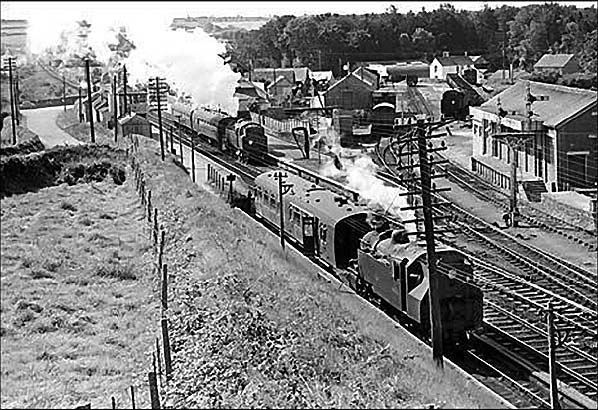 An elevated view looking due south across Halwill station, believed taken in April 1964. By this time Halwill came under BR Western Region so if the date is correct steam would soon be ousted by diesel multiple units. In the Torrington bay, foreground, an Ivatt 2MT tank waits to depart bunker-first with the usual single Bulleid coach which is a brake composite. Presumably first class accommodation was advertised on the Torrington trains but one wonders just how many passengers opted for this relative luxury on these lightly used services. In those days first class was generally double the second class fare. At the main part of Halwill station a BR Standard 4MT tank departs with a train for Bude. A third locomotive is present, in the goods yard. It appears to be another 4MT tank and not involved with shunting wagons of which very few are present. It is probably involved in the joining and splitting of passenger trains, this being a regular occurrence at Halwill. This view has a number of similarities to one of those taken one year earlier on 20 April 1963. Both tanks on passenger tanks being the same type and both running bunker-first; the first coach of the 2-car Bude train coupled with its brake-end innermost; the open door near the brake-end of the Bulleid coach. However, we know this view was taken at a different time as the Ivatt tank has its headcode disc in a different (and incorrect) position relative to the 1963 view. Presumably the Ivatt had not been fitted with irons to suit the Southern disc system which remained valid, insofar as Halwill was concerned, into Western Region days.
Photo from John Mann collection 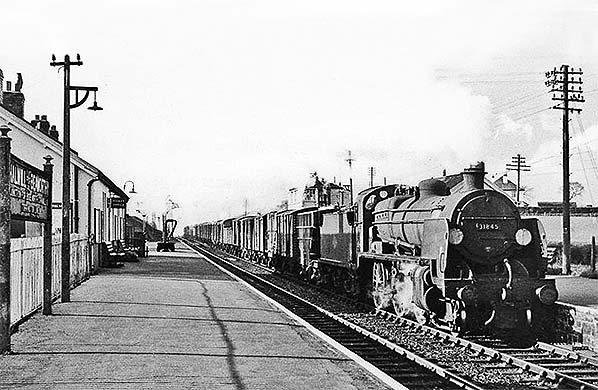 April 1964 and a lengthy mixed goods train from Padstow clatters south through Halwill. The train comprises a mix of open wagons and closed vans, plus a 'Presflo' behind the locomotive. There is also at least one loaded Conflat, third wagon behind the locomotive. It is likely the train did not depart Padstow at this length but picked up further wagons at Wadebridge. An Exmouth Junction resident at this time, No.31845 was withdrawn five months after this photograph was taken.
Photo by Ben Brooksbank 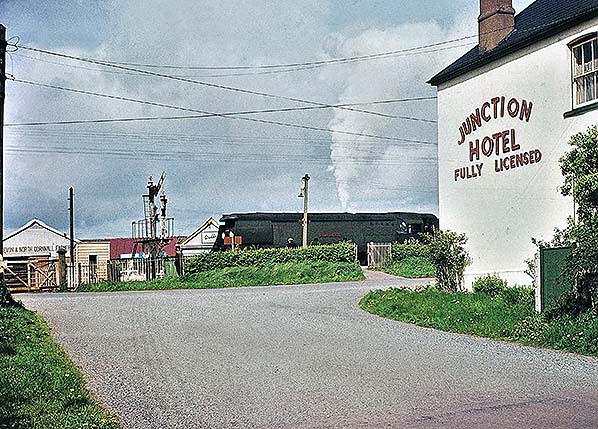 May 1964 and Bulleid West Country class No.34106 'Lydford' prepares to depart from Halwill towards Okehampton heading the Atlantic Coast Express. In the left background a shop of the West Devon & North Cornwall Farmers co-operative can be seen. Although the name is now defunct, it is thought the business is now part of Countrywide Farmers. The Junction Hotel is still in business today, as the Junction Inn. Inside a number of railway photographs and other related items are displayed. Viewed here from Dreybury Lane, the camera would today be looking towards the housing development of Halwill Junction, the settlement which grew up around the railway and which is a different location to Halwill itself. As for 'Lydford', she had been an Exmouth Junction resident since early 1958 and was withdrawn four months after this photograph was taken when a mere fourteen years old. She had been scrapped by the end of 1964.
Click here for Halwill Gallery 4: August 1964 - c1964 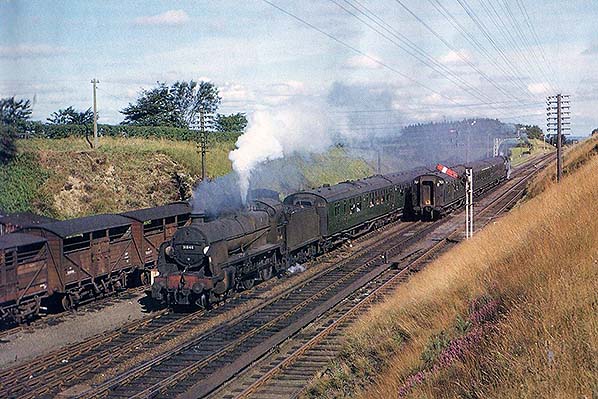 An interesting and relatively usual view just north of Halwill station and showing two portions of the Atlantic Coast Express (ACE). The locomotive is Maunsell N class No.31846 and the date is Saturday 22 August 1964. This locomotive, together with the ACE, was withdrawn the following month but No.31846 is nonetheless maintaining a good head of steam as she comes off the North Cornwall line with the Padstow portion of the ACE. The lack of a headboard was not unusual particularly, apparently, on Saturdays but carriage roofboards also appear to be absent. The train, which had departed Padstow at 8.30am, comprises Bulleid 5-set No.838 and was one of the sets allocated to Waterloo - Weymouth and Waterloo - West of England routes. The train on the right is the Bude portion of the ACE, comprising a Bulleid 3-set. It had departed Bude at 9.30am and arrived Halwill 10.10am. Coupled to its far end is BR Standard 4MT tank No.80039. This train would linger at Halwill for sixteen minutes. The procedure was as follows. The Bude portion of the ACE would arrive at Halwill station and the locomotive run round. Then with passengers from Bude and stations to Dunsland Cross remaining on board would draw out the station to where it is seen here and await the arrival of the Padstow portion, due at 10.22am. Once the Padstow portion was at the platform, the Bude portion would be pushed to the station and the two trains coupled. The Bude locomotive, No.80039 in this instance, would detach and run to the locomotive sidings behind the goods yard. In the down direction the procedure was reversed, not just with the ACE but also with dividing Exeter or Okehampton to Padstow/Bude local services. With the Padstow and Bude portions coupled, the ACE would then depart Halwill at 10.26am. With additional portions attached along the way, the ACE would not reach Waterloo until 3.40pm. While these timings may appear tediously slow, not helped by the ACE calling at almost every little wayside station within the West Country, if the railways to Halwill, Bude and Padstow were still open today the journey time would probably not be much of an improvement. Worth mentioning is that there was also an ACE portion from Torrington but this ran via Barnstaple where it joined with yet another portion from Ilfracombe. Certain portions had, however, already been withdrawn prior to the demise of the ACE. The stock of the Bude portion seen in this view cannot be identified. The set is either 701, 761 or 781 but is too unclear to confirm which. The track in the foreground is the Torrington branch, which parallels the Bude branch before swinging away eastwards beyond the end of the cutting in the distance. A mix of upper and lower quadrant signals can be seen and in particular the rather oddly sited lower quadrant where the North Cornwall line swings away. On the left, a rake of cattle wagons are stabled on the goods yard headshunt. Once a common sight across the network, these wagons were generally XP rated which meant they were fitted with the continuous brake and screw couplings and could be attached to passenger trains but with speed restrictions applied according to wheelbase and other factors. During the 1960s British Rail reduced the speed limits for such wagons following a number of derailments and despite the general loss of such traffic to road transport this helped to hammer the final nail into the railway cattle traffic coffin. One aspect of the railway now largely forgotten is that certain staff were required to be competent in livestock handling and welfare. Cattle, sheep, pigs etc. had to be fed, watered, wagons and pens cleaned and veterinary assistance summoned if necessary. All this was the responsibility of the railway and offers a glimpse at one of the many reasons why wagon-load traffic was uneconomic and ultimately phased out.
Photo from Jim Lake collection 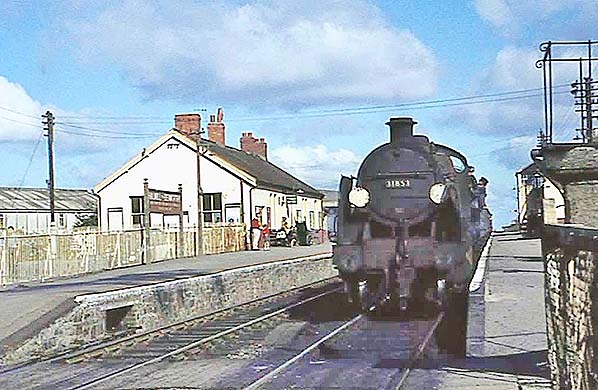 Halwill in August 1964 with 'Mongoliper' N class 2-6-0 No.31853 standing at the up platform. One of the Ashford-built examples, she was withdrawn the following month having been resident at Exmouth Junction shed since June 1959. We need to examine the broader picture to determine what precisely is happening in this scene. No.31853 appears to be heading a goods train of open wagons and what is presumably the fireman is leaving, or climbing back onto, the footplate. The level crossing is closed to the road and a number of intending passengers are waiting on the down platform. It would therefore appear a passenger train is approaching from the south and once this has cleared the single line section and the necessary token exchange completed No.31853 will trundle on her way. The simplistic but very presentable station building will be noted, as will the Halwill & Beaworthy running-in board bearing 'change here for' information which at this time was all still relevant.
Photo received from Sid Sponheimer 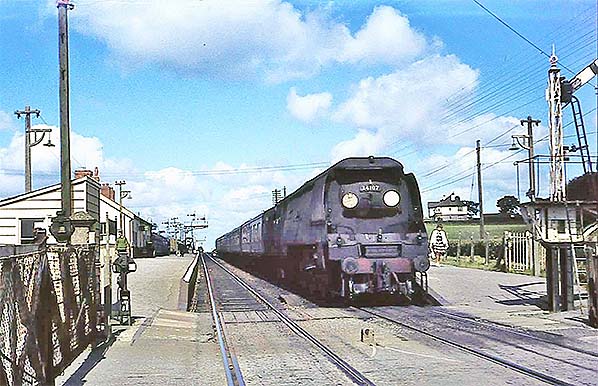 On 29 August 1964 unrebuilt Bulleid Pacific No.34107 'Blandford Forum' is signalled away from Halwill. The train is presumably a portion of the Atlantic Coast Express (ACE) and comprises portions from Padstow and Bude which will have joined at Halwill. This may explain the presence of the second locomotive visible in the distance, which may have come off the Bude portion. The splitting and joining of ACE portions at Halwill was a complex affair and one probably responsible for the shunt signal on the left which applied to movements on the down line but in the up direction. Out of view to the left was the south end of Halwill goods yard, on the west side of which was the locomotive turntable. A third locomotive appears to be present either in the bay platform or near the goods shed, both being in the left background. The signals in the background were on two separate gantries and not one as this view may imply. They were the down starting signals and applied to the junctions to the north of the station. The stubby post between the tracks in the foreground was for the level crossing gates. In contrast to the rest of the station, the gates themselves appear to have been in a quite shabby condition by this date. The train is formed of mainly Bulleid stock but, ironically, the vehicle immediately behind the locomotive isn't so easy to identify. It has the look of an ex-GWR Collett vehicle about it but in actuality is probably of Maunsell origin. The ACE ceased to run shortly after this photograph was taken, as did No.34107 and she had been scrapped by the end of the year. As is well known, the lines serving the coastal towns of Devon and Cornwall very much relied upon the seasonal holiday trade as indeed did many others. Devon and Cornwall are delightful counties with plenty to offer so it is sad to think this has largely been forsaken for foreign holidays with supposedly guaranteed sunshine, plus budget airline sandwiches along the way. Had this not been the case and as with other locations in Devon and Cornwall which did manage to keep their railways, it may have still been possible today to pass through Halwill by train, albeit in a clinical modern DMU complete with tedious announcements, no room for bicycles and the ever-present threat of reprisals against those travelling with the wrong ticket no matter how innocently it was purchased. On 29 August 1964 unrebuilt Bulleid Pacific No.34107 'Blandford Forum' is signalled away from Halwill. The train is presumably a portion of the Atlantic Coast Express (ACE) and comprises portions from Padstow and Bude which will have joined at Halwill. This may explain the presence of the second locomotive visible in the distance, which may have come off the Bude portion. The splitting and joining of ACE portions at Halwill was a complex affair and one probably responsible for the shunt signal on the left which applied to movements on the down line but in the up direction. Out of view to the left was the south end of Halwill goods yard, on the west side of which was the locomotive turntable. A third locomotive appears to be present either in the bay platform or near the goods shed, both being in the left background. The signals in the background were on two separate gantries and not one as this view may imply. They were the down starting signals and applied to the junctions to the north of the station. The stubby post between the tracks in the foreground was for the level crossing gates. In contrast to the rest of the station, the gates themselves appear to have been in a quite shabby condition by this date. The train is formed of mainly Bulleid stock but, ironically, the vehicle immediately behind the locomotive isn't so easy to identify. It has the look of an ex-GWR Collett vehicle about it but in actuality is probably of Maunsell origin. The ACE ceased to run shortly after this photograph was taken, as did No.34107 and she had been scrapped by the end of the year. As is well known, the lines serving the coastal towns of Devon and Cornwall very much relied upon the seasonal holiday trade as indeed did many others. Devon and Cornwall are delightful counties with plenty to offer so it is sad to think this has largely been forsaken for foreign holidays with supposedly guaranteed sunshine, plus budget airline sandwiches along the way. Had this not been the case and as with other locations in Devon and Cornwall which did manage to keep their railways, it may have still been possible today to pass through Halwill by train, albeit in a clinical modern DMU complete with tedious announcements, no room for bicycles and the ever-present threat of reprisals against those travelling with the wrong ticket no matter how innocently it was purchased.Photo received from Sid Sponheimer 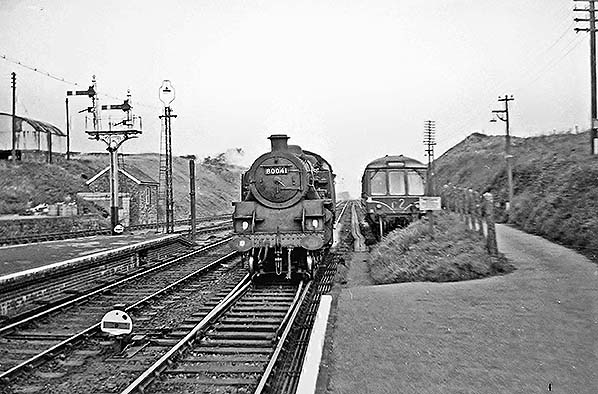 The north end of Halwill station in the 1960s. On the right a single-unit railcar, later Class 122, waits at the rudimentary and slightly comical Torrington bay platform. The North Cornwall & Devon Junction Light Railway had its origins in a narrow gauge (3ft) line serving the ball clay industry. Under the auspices of Colonel H. F. Stephens it was converted to standard gauge and extended through to Halwill, which it reached in 1925. It was this late date which, together with the line being a light railway, was the reason for the bay platform having to use what space was available at the pre-existing Halwill station and thus was a rudimentary affair. Perhaps more to the point was what the NC&DJLR could afford or was willing the pay the Southern Railway. The line remained independent until Nationalisation. Only six years older than the diesel railcar is BR Standard 4MT 2-6-4T No.80041, seen here performing some sort of manoeuvre but quite what is unclear. It has not used the crossover, not is its front end displaying a headcode. The 4MT tanks busied themselves in the area alongside Ivatt 2-6-2T's and other BR Standard types, both tank and tender. Staying with the relevant 4MT tanks, following one of two teething troubles the type were decent and powerful, for their size, machines. Under the direction of Robert 'Robin' Riddles the type was designed at Brighton, where the majority of the 155-strong class was built. They were based upon the LMS Fairburn 2-6-4T but incorporated features common to all the BR Standards intended to make the work of the crews and fitters easier. Loading gauge considerations resulted in the distinctive curve to the water tanks and cab when compared to the Fairburns. One problem which affected some the class and which should have been picked up upon the design stage was the tank ventilators obstructing drivers' view. No.80041 was one of those so-plagued, the design being modified from No.80059 onwards. Allocated from new to all BR regions apart from the Western, they were thus 'foreigners' when the WR took over the former Southern lines in the South West. No.80041 was based at Exmouth Junction from July 1962 until June 1965. Diesel railcars appeared in 1963, with the WR takeover, so this view will date from the 1963 - 1965 period. She carries no shedplate but the outline of, and mounting bolts for, are visible on the smokebox door. Fifteen of the class survive in preservation but No.80041 is not among them, she was withdrawn in March 1966 and scrapped soon afterwards. Having not even seen fourteen full years service, this highlights well the saga of the BR Standard steam locomotives albeit not as bad as certain of the diesels which replaced them, which did not even attain a service life reaching double figures.
Photo received from Sid Sponheimer 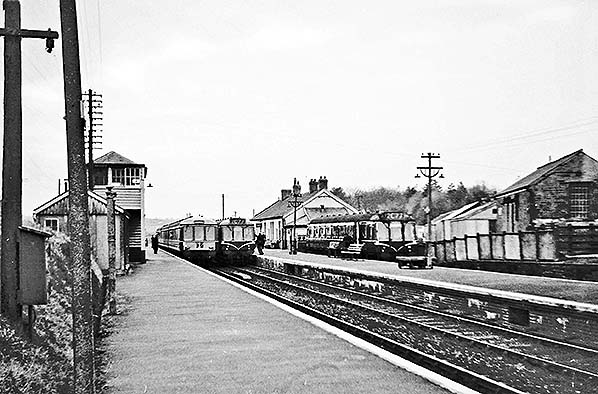 Halwill was one of those railway gems which are now found only in the history books; a rural station somewhat 'in the middle of nowhere' and yet which could be a hive of activity as the junction for several branch lines as well as seeing main line trains. One such hive of activity can be seen here in this 1964 view. In the down main platform and the bay two single-unit railcars of what became Class 121 can be seen, built by the Pressed Steel Co. in 1960. Both are displaying headcode 2C77; '2' indicating branch or secondary service; 'C' indicating the Western Region's Plymouth Division; '77' indicating the route which in this case was Bude. The railcar at the main platform has probably come from Okehampton while that in the bay is probably on layover between Halwill - Bude shuttles. At the up platform a Class 116 3-car DMU stands. It will be rasping away towards Okehampton and perhaps Exeter. The unit displays the 2-character type of headcode fitted to many DMUs. It is showing 'C2', the usual code for units so-fitted in this area and which means simply Plymouth Division (C) local/branch service (2). In other words the same as the first two characters as used in the 4-character headcodes but reversed. For the benefit of readers unfamiliar with train headcodes, their purpose was to enable staff and in particular signalmen to identify the type and route of trains. Further, the railway used these codes to reference trains in logs, working timetables and other documentation. Headcodes are still used today but are no longer displayed on trains as centralised signalling and electronic train identification methods have rendered the practice unnecessary. The exception was the electric trains of the former Southern Region which continued to carry 2-character route numbers but this has, at the time of writing, all but been phased out with the introduction of modern rolling stock. Class 116 were 3-car high density, ie suburban, DMUs built at BR Derby Works. Other similar types were built by contractors but Class 116 was distinguishable by not having a roof mounted headcode box. They lacked toilets and, originally, internal gangway connections. The class was allocated new to the Western Region, as were other similar suburban types, but was more familiar on local services in and around the bigger cities such as Birmingham, Bristol and Cardiff. Together with single-unit classes 121/2, their use in Devon and Cornwall offered little improvement over the steam-hauled stock they replaced. Nevertheless, for the first few years after introduction DMUs proved popular with the travelling public and the suburban types were perfectly adequate for local journeys. As with other DMU types, line closures meant they spread their proverbial wings and a few members of Class 116 ended up on suburban services out of King's Cross until displaced by electrification. A long way from King's Cross, the 42-lever signal box at Halwill has been stated as being the largest box on a single-track system anywhere in the country but the claim is far from being true. What might be true is Halwill box, after all routes to the station were opened, being the most complex on a single-track system by virtue of its containing no less than four Tyers single line tablet instruments. As in other views, the Southern fixtures and fittings, including 'targets' are to be noted as is what is presumed to be telephone on the far left although quite what its purpose was, being so close to the signal box, is unclear. Photo received from Sid Sponheimer old1.jpg) Pressed Steel Co. diesel railcar No.W55031 waits in the down bay at Halwill. It is displaying the headcode, 2C77, for Bude. Certain features are worth a mention. Note how the overhead warning flashes have been positioned partly over the so-called 'speed whiskers', creating something of a visual mess. Speed whiskers were to be phased out and replaced by yellow warning panels whilst the warning flashes would have been positioned according to a BR directive. Later, a single flash was usually positioned at the top of the windscreen on the secondman's side, ie on the left as we look at No.W55031. These flashes were introduced following one or two tragedies involving firemen climbing onto steam locomotive tenders or bunkers beneath overhead wires. Flashes became a standard fitting regardless of whether vehicles operated beneath overhead wires or not. Below the two marker lights are the blue square coupling codes, these indicated to staff that units with the same code could couple together and work in multiple with all units so-coupled being controlled from the leading cab. On the bufferbeam the various connections for vacuum, air and electrical jumper cables can be seen. Vacuum was for the brakes and air for the epicyclic gearbox (not 'preselect' as they are sometimes misdescribed). Warning horns were also below the bufferbeam. At the bottom corner of the dash the railcar's data panel can be seen. This gives information on weight and dimensions as well as the date the railcar was new, in this case 4 - 12 - 60 (4 December 1960). Also present are the letters MBS, for Motor Brake Second. The SP date is also given (workshop date) but it is too unclear to read for certain although it appears to be 12-65 (December 1965). This is the only clue we have as to the date of this photograph. It may be observed that DMU destination blinds in the area were usually left blank. The reason was not laziness but because the units were fitted with Western Region blinds when new and these did not foresee the takeover by the WR of the ex-Southern lines in the West Country. Bodmin, however, was on the blinds due to the Bodmin Road - Bodmin General section and it is thought Padstow also appeared on the blinds of certain units. On the platform, the trolley can be seen marked 'Halwill J -'. This was common practice and done for accountancy reasons. The double bracket platform lamp will also be noted as will the concrete 'fencing' on the right, another product of the Southern's Exmouth Junction concrete works. Of No.W55031, she went on to enter departmental stock as one of the Severn Tunnel emergency trains as did No.W55027 and both are now preserved. Meanwhile, as of 2016, two, 55020/34 remain in revenue service while a third, 55022 remains in non-passenger use as a route learner.
Photo by Rev. Peter Westall old2.jpg) A DMU enthusiasts delight at Halwill, very likely on the same day as the view of No.W55031 (above) in the down bay, seen here in the left background. At the down platform another Pressed Steel Co. single-unit stands displaying headcode 2C61 on its rear, This was the code for Okehampton - Halwill. In the Torrington bay stands another single-unit, this time one of the Gloucester RC&W cars, later Class 122. This view can therefore be dated to the 1963 - 5 period. Entering the up platform and apparently emerging from the sidings is a 3-car DMU of what became Class 116. When you think, for example, of commuters from King's Cross having to put up with two decades of Cravens DMUs on many suburban services for which the Cravens were totally unsuited, you must wonder why high density suburban units such as Class 116 were seen pottering around the byways of Devon and Cornwall. The answer probably lay with diagrams; the Plymouth Division's high density units would be found on more appropriate services during the peak hours and for school traffic, with quieter periods and weekends spent on said byway potterings. In the event, a handful of Class 116 did end up on King's Cross suburban duties but that is another story. On the up platform is a mix of railway staff, ordinary passengers and railway enthusiasts. Whilst the latter might suggest the Class 116 is operating a railtour, there are not enough enthusiasts present for this to have been the case so the DMU is most likely about to operate a normal service to Okehampton. The water column, right, still has its bag, suggesting steam in the area has not yet come to an end. Once the flurry or activity seen here was over Halwill station would retreat back into peaceful slumber for a couple of hours until the rasps of the next DMUs to arrive and depart reverberated around the surrounding countryside and perhaps with the occasional clatter
of a goods train in between. Photo by Rev. Peter Westall old3.jpg) A Gloucester RC&W diesel railcar, later Class 122, rasps away from the Torrington bay at Halwill. This is probably the same service as seen in the picture showing the Class 116 unit. The railcar seen here has a small yellow warning panel and an overhead warning flash in the windscreen at the top and 'Overhead Live Wires' at the bottom. They are still in use today although design can vary. The cloud of smoke from the departing railcar was typical of what we now call 'First Generation' DMUs. It was caused by a build-up of unburned lubricating oil following periods of engine idle. DMUs were frequently left in stations between services with their engines idling for a number of reasons, the main one being maintaining of vacuum for the brakes. Otherwise, an engine shutdown would require the parking brake to be applied and, if stopped for for any length of time, the battery isolating switch to be opened. Failure to do this could result in drained batteries. The battery isolator was located on the underframe but precise position varied according to builder. So it was that DMUs were frequently seen idling away at platforms between services, with the characteristic rattle of the drive to the cooling fans, and clouds of blue smoke when the engines were revved upon departure. Other points to note in this view are, left, the lower quadrant signal on the North Cornwall line and in the 'off' position and the shunt signal, left-most of the two visible in the distance, also in the 'off' position. In the distance the runround loop for the Torrington branch is just discernable but there is no obvious sign of the connection to the main line. On the right, the bay running-in board had been altered to show simply 'Halwill', it previously having also displayed 'Junction'. This alteration was rather a waste of money, unless the original board needed replacement for some reason, as was the placing of a 'target' nameboard in close proximity. The up line into the main platform now has a length of flat bottom rail while prominent on the left is the water column, one of three at Halwill, presumably used by locomotives in the down bay.
Photo by Rev. Peter Westall old6.jpg) The diesel railcar seen approaching Halwill previously is seen here having departed for Padstow and branching off onto the North Cornwall Line past the surviving lower quadrant signal. On the right is the Torrington bay platform with its 'target' nameboard on the lamp standard and running-in board which by this time informed arriving passengers only that they were at Halwill. It had previously announced 'Halwill Junction', this board presumably having originated with the light railway. The line to Torrington was never part of the Southern Railway and only became part of the Southern Region at nationalisation. Despite this, the platform is faced with concrete, suggesting the it had been constructed by the Southern Railway for the former light railway. It was, after all, built on the Southern's land but Colonel Stephens is also known to have used concrete to a limited extent. The lamp standard on the Torrington platform is something of a mystery. It is clearly a product of Exmouth Junction Concrete Works but when it was installed and who by is unclear. Station lighting at Halwill was changed to electricity, from oil, believed sometime during the 1930s but whether the lamps on the Torrington platform (there was three) were installed by the Southern for or at the behest of the light railway or after nationalisation remains a mystery. In the left foreground some of the point rodding and signal wire runs can be seen. Towards the bottom of the lattice post on the left is a switch box and under close examination trunking is visible going up the post. This might suggest the signal lamps were electric but at the time of writing no confirmation of this has been found.
Photo by Rev. Peter Westall old9.jpg) A Gloucester RC&W diesel railcar, later Class 122, waits in the Torrington bay at Halwill. This is probably the same service as seen in the picture showing the Class 116 unit. The railcar seen here has a small yellow warning panel and an overhead warning flash in the windscreen as described elsewhere. These warnings displayed a red 'lightning bolt' device and the wording 'Danger' at the top and 'Overhead Live Wires' at the bottom. They are still in use today although design can vary. In the 'six foot' can be seen a Westinghouse shunt signal of the design peculiar to the Southern. These were prolific at Halwill due to the number of terminating trains and others which involved the attaching and detaching of vans and/or passenger stock. Both down side water columns can be seen in this view.
Photo by Rev. Peter Westall old11.jpg) Viewed from the signal box, the diesel railcar rasps away from the bay platform on its way to Bude. The characteristic smoke from the exhaust stacks will clear after a short distance, only to reappear upon departure from Bude due to the railcar idling in the platform following arrival. The pitched roof at right foreground was of the concrete hut, another Exmouth Junction product. The roof appears to be of corrugated asbestos and this form of concrete plus asbestos (or corrugated iron) construction was once very common. Ahead of the camera the Torrington bay platform can be seen with its apparently never-far-away barrow. From this angle it is clear how part of the hillside was cut back to accommodate the platform. It is from the top of this hill that the elevated views across the station elsewhere in these pages were taken. Viewed from the signal box, the diesel railcar rasps away from the bay platform on its way to Bude. The characteristic smoke from the exhaust stacks will clear after a short distance, only to reappear upon departure from Bude due to the railcar idling in the platform following arrival. The pitched roof at right foreground was of the concrete hut, another Exmouth Junction product. The roof appears to be of corrugated asbestos and this form of concrete plus asbestos (or corrugated iron) construction was once very common. Ahead of the camera the Torrington bay platform can be seen with its apparently never-far-away barrow. From this angle it is clear how part of the hillside was cut back to accommodate the platform. It is from the top of this hill that the elevated views across the station elsewhere in these pages were taken.Photo by Rev. Peter Westall old12.jpg) Looking along Halwill's down platform towards Okehampton prior to March 1965. On the right and partly obscured by the water column is a Pressed Steel Co. diesel railcar on the Bude service. In the distance another railcar of the same type approaches the station on a Padstow service. There are people (and staff) waiting on both platforms so perhaps another train is due at the up platform. Alternatively the railcar may have arrived from Padstow, unloaded its passengers and is reversing. A few trains did this but unless any passengers wished to change for stations to Bude or Torrington the practice was somewhat pointless, as was terminating trains from Halwill at Torrington. Just visible is the 'target' nameboard which had by this time appeared on the signal box supporting column. On the right is a reasonable view of one of the Southern's double lamp standards. Curiously Exmouth Junction Concrete Works also produced concrete signal posts but these were unsuccessful and production ceased after a couple of years. This was in total contrast to the lamp standards which proved extremely long lasting and as of 2016 a few can still be seen doing the job they were designed to do, notably at a number of stations in Kent. Looking along Halwill's down platform towards Okehampton prior to March 1965. On the right and partly obscured by the water column is a Pressed Steel Co. diesel railcar on the Bude service. In the distance another railcar of the same type approaches the station on a Padstow service. There are people (and staff) waiting on both platforms so perhaps another train is due at the up platform. Alternatively the railcar may have arrived from Padstow, unloaded its passengers and is reversing. A few trains did this but unless any passengers wished to change for stations to Bude or Torrington the practice was somewhat pointless, as was terminating trains from Halwill at Torrington. Just visible is the 'target' nameboard which had by this time appeared on the signal box supporting column. On the right is a reasonable view of one of the Southern's double lamp standards. Curiously Exmouth Junction Concrete Works also produced concrete signal posts but these were unsuccessful and production ceased after a couple of years. This was in total contrast to the lamp standards which proved extremely long lasting and as of 2016 a few can still be seen doing the job they were designed to do, notably at a number of stations in Kent.Photo by Rev. Peter Westal Click here for Halwill Gallery 5: c1964 - 1966l old13.jpg) Staff, of which there were plenty, are earning their keep in this view of the north end of Halwill station. The man on the right with the light coloured jacket is probably a Royal Mail employee while, left, a porter is transferring a large suitcase to the railcar in the bay. Ahead of him, the cap badge of the smartly-uniformed man can been seen under magnification to be the once familiar British Railways 'hot dog' type. He is probably the guard of the railcar in the bay and supervising the loading of luggage etc. into his domain. On this occasion the railcar in the bay is one of the Gloucester RC&W examples, later Class 122. On the right is Gloucester RC&W No.W55000, the doyen of the class, coupled to what will either be another single-unit or a Class 116; this train is bound for Bude. Unfortunately such details were seldom recorded by photographers and especially where diesels were concerned. No.W55000 will depart, presumably with companion, towards Launceston and perhaps Padstow. This railcar was one of several to survive into preservation and at the time of writing is at the South Devon Railway.
Photo by Rev. Peter Westall old10.jpg) The final of the series of pictures taken by Rev. Peter Westall on an unknown date between 1963 and March 1965. A relatively busy moment at Halwill, with the people on the up platform being suggestive of a third train due to appear. The railcar in the bay is probably No.W55031 as seen above while that at the opposite platform is another, but unidentified, Pressed Steel Co. single-unit bound for Bude. The headcode, 2C69, tells us it is heading for Padstow. Visible here are the solid bulkheads behind the driving cab at the brake end of the railcar. At the opposite end passengers had a view through the cab, this being one of the features which made DMUs popular when first introduced. Halwill suffered no shortage of Southern 'target' style nameboards with seemingly every lamp standard so-adorned. Another can be seen here attached to the stilt at the near end of the signal box
Photo by Rev. Peter Westall 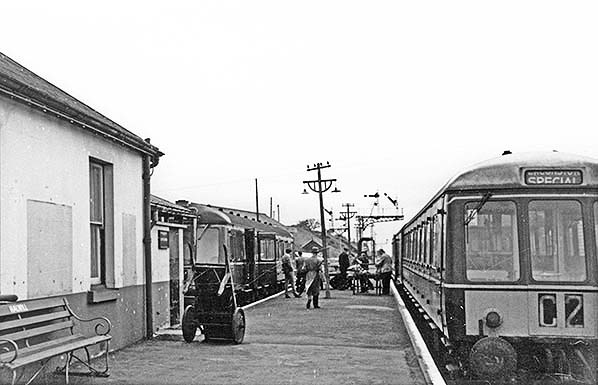 Undated views such as this can, due to the presence of the diesel railcars, be pinned-down with some certainty to the 1963 - 6 period but although this may be correct other aspects are not always what they seem at first glance. This view is believed to depict the very limited number of trains which served Halwill on Sundays and which ran largely for the benefit of Royal Mail. These comprised a single journey to Launceston and two to Bude. The train on the right, which will be operating the Bude services, has caused some puzzlement as it appears to be a driving motor from a Class 116, as they became, DMU coupled to another vehicle which is unidentified. The suspected Class 116 car is that nearest the camera and it appears to have too many seating bays for it to be a single-unit railcar. However, it should be borne in mind that camera angles and distractions such as open doors can create illusions. A Gloucester RC&W single-unit railcar stands in the bay and the activity on the platform looks like parcels etc. being transferred from one DMU to the other. A larger version of this image suggests the men standing near the railcar in the bay are railway enthusiasts as at least one is carrying the requisite accoutrements. The man nearest to, and with his back towards, the camera is wearing a bowler hat suggesting he is present in an official capacity, either for BR or Royal Mail although officialdom was not usually required for such operations - staff simply got on with their job and that was that. Signals are 'off' for both Launceston and Bude routes, despite neither train clearly being not ready to depart. This may suggest Halwill signal box was 'switched out' on Sundays. Certainly this would have been possible given that only the three services described above operated on Sundays and the track layout would have permitted it but at the time of writing this detail remains unconfirmed
l
Photo from John Mann collection 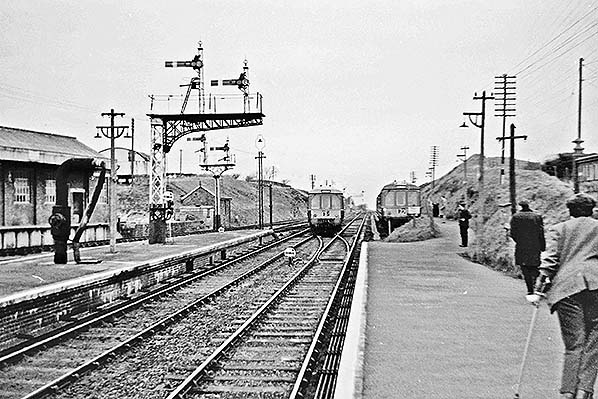 Halwill looking north on 27 February 1965. This was the last day of passenger services on the Halwill - Torrington section, official closure day being 1 March 1965. In the Torrington bay on the right, a rather basic 'afterthought' type affair typical of Colonel Stephens involvement, a DMU stands working a special for enthusiasts to mark the last day. This was more a charter train than a railtour and although it was photographed numerous times on its journey, not a great deal is known about it from the organisational aspect. The train appears to have run as far as Bideford and is also thought to have been the very last passenger train to traverse the Halwill - Meeth section. The train was a hybrid 3-car DMU, formed from two cars of a Class 116 DMU, as the type was to become known, and one car from a Swindon Class 120. Approaching the station on the crossover is another Class 116 DMU. it having come off the Wadebridge/Padstow line. Class 116 is described in another image caption. On the left is the down side bay platform with the slaughterhouse beyond. Also visible are the water crane on the down platform, some Southern 'target' nameboards and some Westinghouse shunt signals of the style peculiar to the Southern Railway. One of these is mounted on the signal post to the left. Other evidence of the Southern is the distinctive lamp standards.
Photo received from Sid Sponheimer 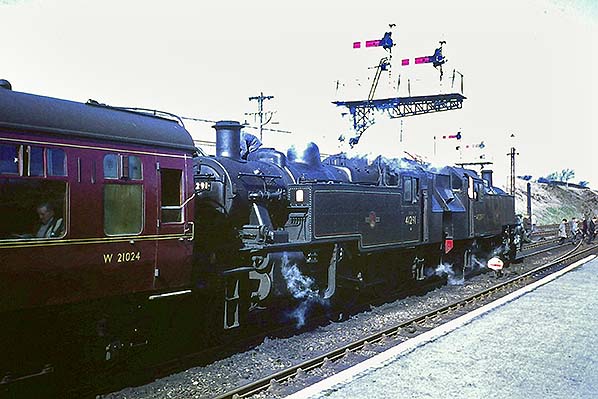 On 27 March 1965 The Exmoor Ranger railtour stands at Halwill while some of its patrons kindly help BR to ensure the track is all in order! Details of the tour can be read via the link but an interesting point concerns the train operating over the Halwill - Barnstaple route, of which the Halwill - Meeth section had closed completely almost a month previously. The five carriage train contained BR Mk1 W21024 as seen here. The train is about to leave Halwill and will proceed along the Bude line before branching off via the one and only connection at Halwill onto the Torrington branch. Other photographs from this period suggest the track as far as Meeth was lifted very soon after this railtour ran. The locomotives are Ivatt 2MT tanks Nos.41206 (leading) and 41291 (facing camera). Both were Exmouth Junction residents at this time and both were transferred to Templecombe (Somerset & Dorset) later in 1965. No.41206 survived until March 1966 with No.41291 bowing out the previous month. Neither escaped the scrapman. British Rail were a constant target for criticism and ridicule but in truth did a very good job under difficult circumstances while their relations with properly organised enthusiast groups were generally excellent. The running of special trains over freight-only lines and, as here, closed lines was typical of their 'can do' approach providing safety was not too compromised. Such tours are still possible today but with the so-called 'privatised' railway, organisation is a long-drawn-out affair with many Health & Safety stumbling blocks, risk assessments, supposed unavailability of crews and rolling stock (this excuse usually appears at the last minute) and so on. The result is that most tours are now operated by companies set up for the purpose and the days of enthusiast groups organising their own railtours are all-but a thing of the past.
Photo from KDH archive junction_old34.jpg) As if in expectation of a sudden surge of passengers one day in 1965, a suburban DMU of what became Class 116 waits at Halwill. The unit is actually a hybrid, the vehicle at the far end being a Swindon-built example of what became Class 120. A number of photographs exist taken at various locations in the area and showing this unit in hybrid form so it must have ran around like this for some time. Hybrid units were a common sight but the combination of high density suburban with low density 'Cross Country' was unusual to say the least. The formation seen here at Halwill may have arisen through accident or fire damage to one or other unit and the set formed temporarily from serviceable vehicles. Whatever the truth, it does illustrate well the advantage of having units with a common coupling code, in this case Blue Square which eventually became the theoretical standard. There is no tail lamp on the near end of the DMU, yet, but the signal which is 'off' suggests the unit is reversing and will return to either Bude or the North Cornwall line. A feature very common today and which applied to Halwill was the bi-directional ability of the through platform roads as permitted by the signalling. This was essential at Halwill due to the amount of shunting required when trains were split or joined. It was for this reason that Halwill was adorned with numerous shunt signals and had a relatively large, for such a rural location, signal box but it was not, as some sources claim, the largest box on a single-track network.
Photo by Chris Milner old8.jpg) On 5 September 1965 Ivatt 2-6-2T No.41283 stands at Halwill during the Great Western Society's Launceston Branch Centenary Tour. The train was a mix of BR Mk1 and GWR stock, one of the latter appearing to be a Hawksworth bow-ended example. The reason for the train apparently running 'wrong line' at Halwill was to allow No.41284 to run round the train, which has arrived from Launceston and will proceed to Bude. As the link shows, the train had used the connection between Great Western and Southern metals at Launceston. The locomotive bears and 83G shedplate, telling us she was shedded at Templecombe (Somerset & Dorset). New in 1950, she spent much of her life in the north-west until moving south in 1963. She was withdrawn six months after this photograph was taken and scrapped shortly afterwards. At the bottom of her smokebox door and immediately below the shedplate is another plate bearing the initials 'SC'. This indicated she had a Self-Cleaning smokebox. In simple terms, this was a device which used the exhaust blast to pulverise ash, which found its way from the firebox via the boiler tubes, and eject it from the chimney. It was one of several devices designed to make the job of crew and shedmen easier, partly in an attempt to ease recruitment problems and partly to help retain existing staff who were drifting away to cleaner and better paid jobs. The Self Cleaning smokebox was among the features incorporated into the BR Standard steam locomotives which were generally based upon existing LMS designs.
Photo by Rev. Peter Westall junction_old19.jpg) An elevated view looking due south across Halwill station. At the platform is Ivatt 2-6-2T No. 41283 preparing to depart for Bude on 5 September 1965, with the 'Launceston Branch Centenary Tour' tour which has been described above. This is believed to have been the last steam working west of Okehampton and thus the last steam engine to be seen at Halwill excepting, obviously, on the train's return journey from Bude. This view offers a reasonable look at the goods yard and also of the surrounding countryside and thus of the station's fairly remote location. A landmark, still there today, is the Junction Hotel (now the Junction Inn) on the left. The track can be seen snaking its way towards Meldon Junction and Okehampton in the distance. The route can still be traced today, as can the three lines radiating from Halwill towards Torrington, Bude and Launceston. The station site and goods yard is, however, now covered by housing with tediously unoriginal street names such as Beeching Close. Note the enthusiast standing on the signal gantry; railway staff were very relaxed about health and safety issues in those days. An elevated view looking due south across Halwill station. At the platform is Ivatt 2-6-2T No. 41283 preparing to depart for Bude on 5 September 1965, with the 'Launceston Branch Centenary Tour' tour which has been described above. This is believed to have been the last steam working west of Okehampton and thus the last steam engine to be seen at Halwill excepting, obviously, on the train's return journey from Bude. This view offers a reasonable look at the goods yard and also of the surrounding countryside and thus of the station's fairly remote location. A landmark, still there today, is the Junction Hotel (now the Junction Inn) on the left. The track can be seen snaking its way towards Meldon Junction and Okehampton in the distance. The route can still be traced today, as can the three lines radiating from Halwill towards Torrington, Bude and Launceston. The station site and goods yard is, however, now covered by housing with tediously unoriginal street names such as Beeching Close. Note the enthusiast standing on the signal gantry; railway staff were very relaxed about health and safety issues in those days.Photo by Bernard Mills junction_old20.jpg) Halwill with only diesel railcars, a Ford Anglia and a handful of people in evidence in this October 1965 view. The track into the Torrington bay, left centre background, has been lifted the branch having closed in March 1965. Just arrived at the up platform is a train formed of two single-unit railcars. That nearest the camera is a Pressed Steel version, later Class 121, while that at the rear is a Gloucester RC&W version, later Class 122. The main distinguishing difference was the Pressed Steel cars having a four-character headcode box while the Gloucester cars made do with a two-character box below the central windscreen. There were a few other minor differences but in pictures such as this the Gloucester cars, in green livery days, could be distinguished by the lining. On the Pressed Steel cars the cream band around the waist continued round beneath the windscreens in the straight line but on the Gloucester cars it curved downwards before passing beneath the windscreens. Unless the points behind the train were changed immediately it passed over them, the train has arrived from Bude. The headcode displayed is 2C79. This may suggest the train is continuing towards Exeter but could be the result of some changes made by the Western Region around this time Towards the rear of the train two people are leaning out and looking back at something further down the line but what is unclear. Another railcar is waiting in the bay platform. Click here to see a larger version of this picture.
Photo by Bernard Mills 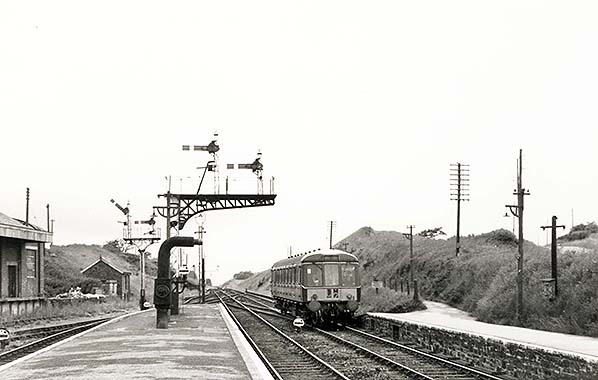 Examination of a larger version of this photograph suggests the track into the Torrington bay, centre background, at Halwill has either been lifted or is heavily overgrown, most likely the latter, whilst directly ahead of the camera the water column has lost its bag. Both these observations would suggest the photograph was taken in the late 1965 into 1966 period. The runround loop for Torrington trains is, however, still in situ but also overgrown. A single-unit railcar, later Class 122, is arriving from Bude. At far left, the tracks into the goods yard and especially that serving the goods shed appear little used. The road is set for the Launceston and Wadebridge route. To the immediate right of the shunt signal mounted on the signal post can be seen, under magnification, the lower quadrant signal on the branch which is also in the 'off' position. For some reason certain LSWR signals survived when others, as seen here, were converted to upper quadrant. On the right a Southern 'target' nameboard can be seen. It is on the lamp post largely invisible by virtue of the camera position placing the lamp post directly in line with the telegraph pole behind it.
Photo from John Mann collection 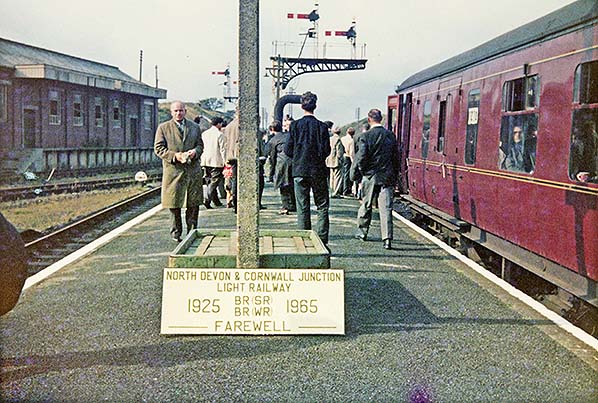 The sign on the platform explains the occasion. The North Devon & Cornwall Junction Light Railway was an extension of the LSWR's Torrington branch and part of the light railway had been rebuilt from its original 3ft gauge clay tramway form. The Halwill to Torrington section closed to passengers on 1 March 1965, freight other than clay traffic having gone in September of the previous year, and the Meeth - Halwill section closed completely and the track lifted. The section between Meeth and Barnstaple, however, remained in use for clay traffic until March 1983. The carriage on the right was ex GWR and in one of its windows is a label displaying 1Z10, this being the headcode assigned to the train with 'Z' being used for any special train such as railtours, excursions or private charters. The Halwill slaughter house, which had its own loading dock, is seen on the left. Compare with early 20th pictures. The slaughterhouse was rebuilt by the Southern Railway in 1930.
Photo from John Mann collection 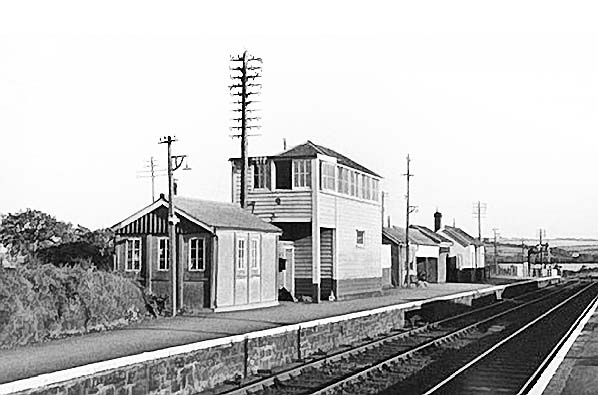 A fairly rare view of Halwill up platform in that the view is unobscured by trains and clouds of steam. Whilst the camera angle is not ideal, the picture may be of some interest to modellers. The date is unknown but it is from late BR days. Electric lighting is present, this being installed sometime during the 1930s. Oil lighting is known to have still been in use in 1931. Dominating the scene is the monstrous carbuncle of a signal box. The type of LSWR box was never particularly attractive but that at Halwill was more ungainly than most. There is much evidence of Exmouth Junction Concrete Works. This had been opened by the LSWR but in the mid-1920s the Southern Railway considerably enlarged it and thereafter its products flooded the system. Visible here are, for example, concrete lamp standards of the typical Exmouth style and the hut, probably a lamp room, directly ahead of the camera. Further along the platform are other small stores huts and the waiting shelter. Southern Railway 'target' nameboards are visible and in later years one also appeared on the pillar supporting the overhanging part of the signal box. A further feature to note is the stone platform facing, quite typical of rural West Country stations. A fairly rare view of Halwill up platform in that the view is unobscured by trains and clouds of steam. Whilst the camera angle is not ideal, the picture may be of some interest to modellers. The date is unknown but it is from late BR days. Electric lighting is present, this being installed sometime during the 1930s. Oil lighting is known to have still been in use in 1931. Dominating the scene is the monstrous carbuncle of a signal box. The type of LSWR box was never particularly attractive but that at Halwill was more ungainly than most. There is much evidence of Exmouth Junction Concrete Works. This had been opened by the LSWR but in the mid-1920s the Southern Railway considerably enlarged it and thereafter its products flooded the system. Visible here are, for example, concrete lamp standards of the typical Exmouth style and the hut, probably a lamp room, directly ahead of the camera. Further along the platform are other small stores huts and the waiting shelter. Southern Railway 'target' nameboards are visible and in later years one also appeared on the pillar supporting the overhanging part of the signal box. A further feature to note is the stone platform facing, quite typical of rural West Country stations.Photo by Chris Knowlses-Thomas junction_old4.jpg)
A 1966 view at Halwill looking south and with plenty of DMUs in evidence. Around this time, the Western Region made some changes to headcodes and two are apparent here. The train at the up platform is a Class 117 unit and is heading for Okehampton and possibly through to Exeter. Class 117 was more familiar on suburban services out of Paddington but a few were based at Laira. Entering the down platform is a pair of single-unit railcars, the leading car being a Gloucester RC&W Class 122 and this ensemble will be heading for Padstow. In the bay stands a BR Swindon unit of Class 120 and one of a batch built for the Western Region with 4-character headcode boxes. It appears to be in 2-car formation so has had its centre trailer removed - a not uncommon occurrence and especially in later years. The Class 120 will be heading for Bude but the headcode is something of a puzzle as '3' indicated a parcels or empty stock working. Perhaps the driver, suspected here of being the gentleman walking towards the cab carrying the accoutrements of the job, will change it. The headcode for Halwill - Bude and vice versa diesel trains was formerly 2C77. Although only a very small part of the goods yard is visible on the right, the impression is gained that it was by then all-but out of use insofar as rail traffic was concerned.
junction_old21.jpg) Halwill station in July 1966 and not all is as it may first appear. Train 2C77, for Bude, is not a pair of single-unit railcars coupled together but two driving motor cars, one a brake, from a normally 3-car Class 117 DMU. These units are best known for operating suburban services out of Paddington but a number also operated from Laira (Plymouth). Built by Pressed Steel, that company's single-unit Class 121 was effectively a double-ended version of a Class 117 Driving Motor Brake, the vehicle furthest from the camera in this view. In the bay a Gloucester RC&W single-unit railcar is seen. The lack of activity suggests it is on layover and will work a later service to Bude or perhaps Padstow, although services to the latter appear t have generally used the main platforms. For a change, the only member of staff visible is the DMU driver. His right hand appears to be on the vacuum brake handle but the train is not about to move as a passenger door is open. What is probably happening is the driver has just entered the cab and is setting up the controls. DMU controls had a detachable reverser key and brake handle, just one set per unit, which had to be transferred from one cab to the other and this is probably what the driver has just done in this view. DMUs also had a key similar to the common Yale type which was used to 'switch on' the drivers' desk. Again this key was transferred from one cab to the other but unlike the detachable controls these keys were issued to, and retained by, drivers.
Photo by M. Taylor junction_old22.jpg) Halwill stations down platform running-in board seen here in July 1966. Of note is the still-present reference to Torrington despite that line having closed the previous year. Perhaps there was a replacement bus service, if so the board retained a little validity. On the left the stationmaster's house can be seen and on the right, with the 'Walls' sign, above a shop. The building largely hidden by the running-in board was the West Devon & North Cornwall Farmers Co-operative (this had no connection with the Co-op chain of stores). Beneath the 'RR' of Torrington the Halwill Junction war memorial can be seen. A selection of period road vehicles can be seen. The lorry at far left appears to be an Austin FFK. Not all others can be identified as they are largely hidden but what can be seen are a Rover P4 and probably a 90, behind the Rover a Mini van, to the right of the Rover a Morris/BMC J2 delivery van, in front of the shop an Austin A40 Farina and standing out from them
all is a Ford Consul MkII. Photo by M. Taylor 11.jpg) Halwill Station looking north in September 1967 shortly after the track was lifted, some of the up platform buildings were still intact at this time although the signal box has been demolished. Halwill Station looking north in September 1967 shortly after the track was lifted, some of the up platform buildings were still intact at this time although the signal box has been demolished.Copyright photo by John Alsop 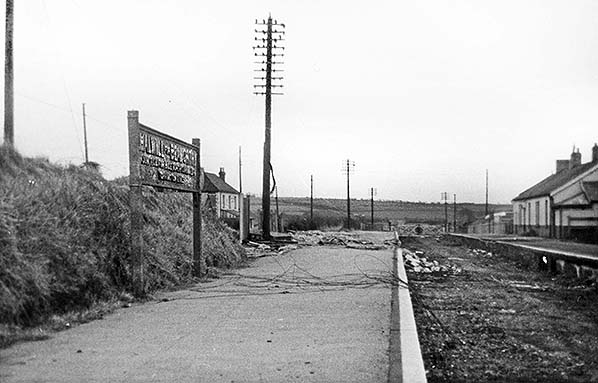 Another view of Halwill station in 1967, shortly after track lifting, looking south. The remaining up platform buildings have now gone.
Photo by G Roose 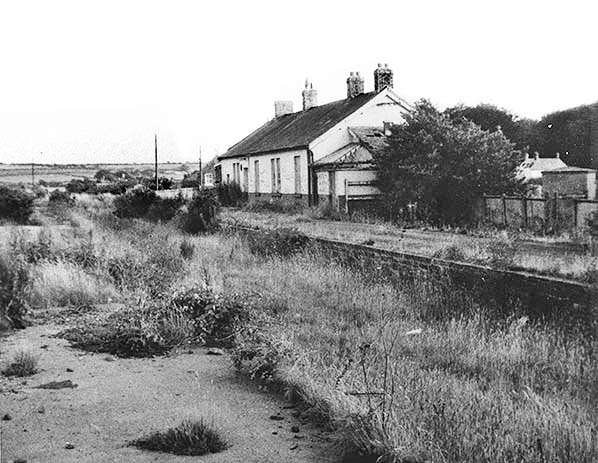
Looking south from the up platform at Halwill station in 1975.
Photo from John Mann collection 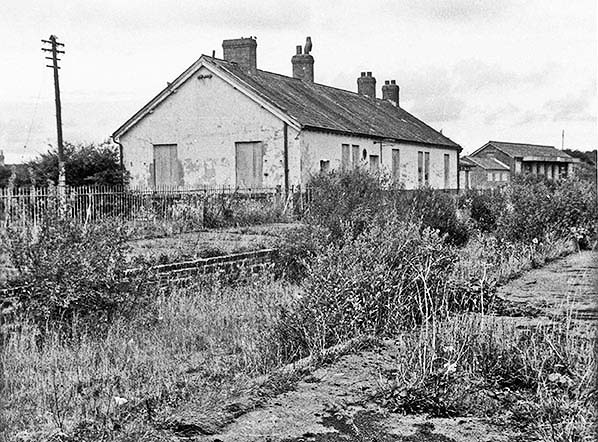
The main station building at Halwill seen from the up platform in 1975. The slaughterhouse is seen in the background.
Photo from John Mann collection 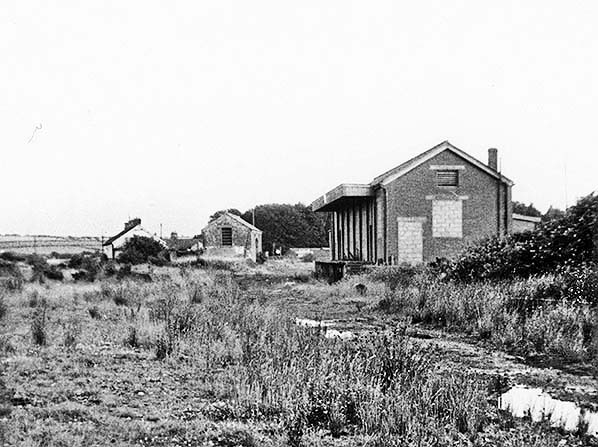
Looking south at the Halwill goods yard in 1975. The buildings seen from left to right are the main station building, goods shed and slaughterhouse. The turntable was beyond the goods shed but is always obscured from view by the slaughterhouse.
Photo from John Mann collection 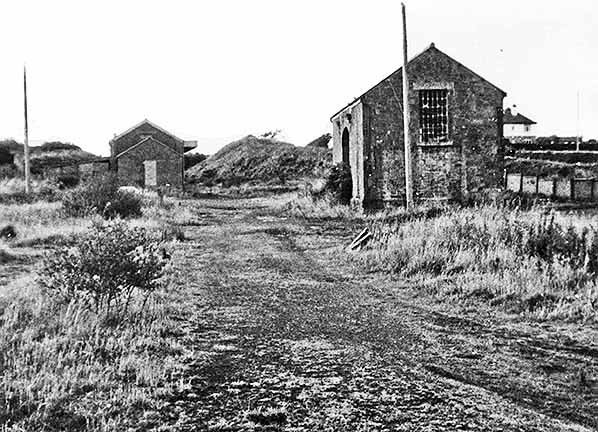 Looking north at the Halwill goods yard in 1975. The goods shed is on the right with the slaughterhouse on the left. The turntable pit is behind and to the left of the photographer.
Photo from John Mann collection 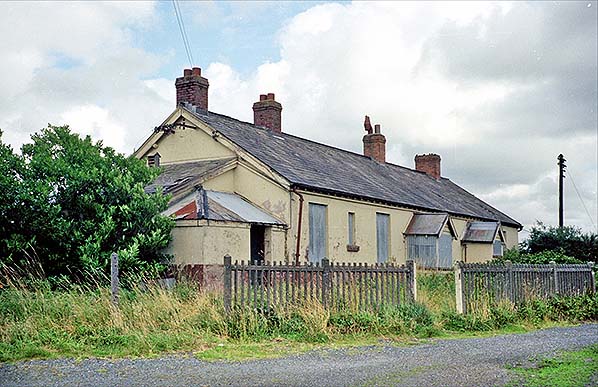 Halwill station forecourt in 1975. The station has been boarded up since closure and not
put to any other use. Photo David Burrows from his Flickr photostream 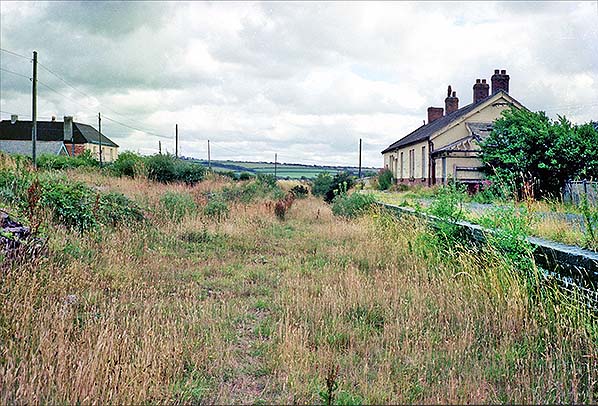
Halwill station looking south in 1975. The Junction Hotel is seen on the left. The up platform is heavily overgrown and barely visible in this view.
Photo
David Burrows from his Flickr photostream
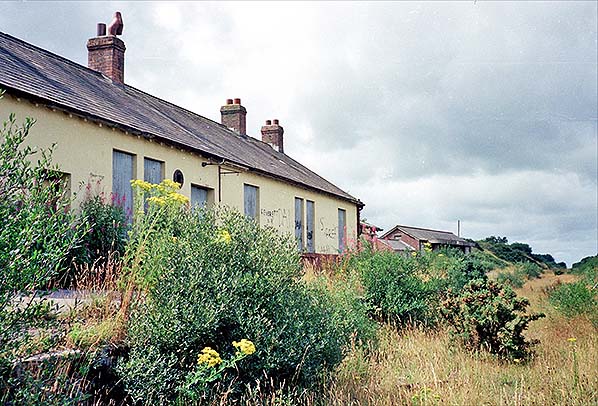 The main station building on the down platform at Halwill in 1975. The Southern Railway's 1930 slaughterhouse is seen beyond.
The main station building on the down platform at Halwill in 1975. The Southern Railway's 1930 slaughterhouse is seen beyond.Photo David Burrows from his Flickr photostream 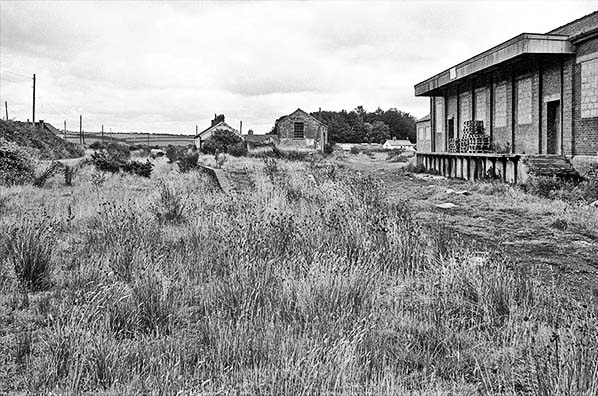 Looking south at Halwill station and goods yard in 1975. The buildings seen from left to right are the main station building, goods shed and slaughterhouse. The down main line platform is also seen with the bay to the rear. Looking south at Halwill station and goods yard in 1975. The buildings seen from left to right are the main station building, goods shed and slaughterhouse. The down main line platform is also seen with the bay to the rear.Photo David Burrows from his Flickr photostream 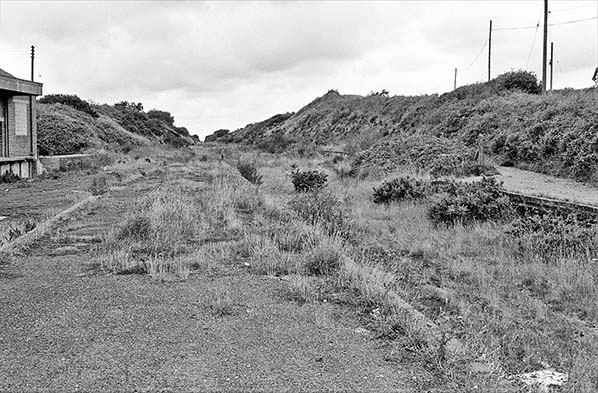 Looking north from the north end of Halwill down platform in 1975. The down bay platform is to the left with the slaughterhouse on the far left. The footpath to the Torrington bay is seen at the end of the up platform and part of the platform can just be made out in the distance.
Photo David Burrows from his Flickr photostream 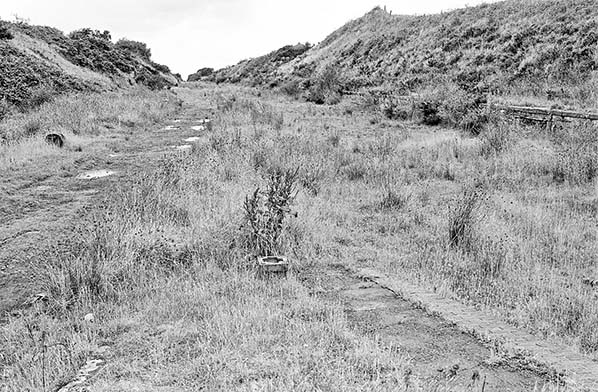
Looking north from the north end of Halwill's down platform in 1975. The Torrington bay platform is seen on the right.
Photo David Burrows from his Flickr photostream 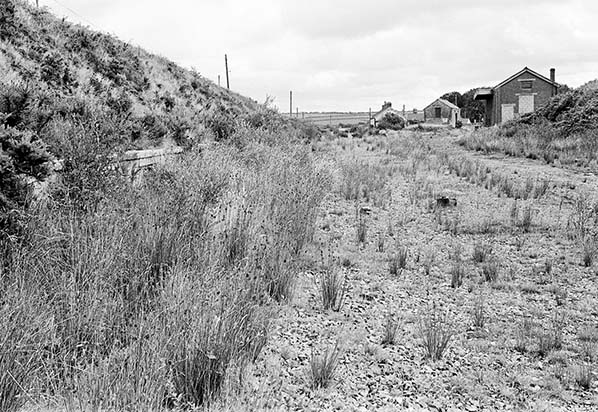
Looking south at Halwill station in 1975. The Torrington bay platform is seen on the left while the main station building and goods yard buildings are seen in the distance.
Photo
David Burrows from his Flickr photostream
12.jpg)
Halwill Station looking south in August 1977, eleven years after closure. Nature has now taken over much of the site. The main station building on the down platform remains in good condition but all down platform buildings have been demolished.
Photo by Alan Young 1.jpg) Halwill Station looking north along the down platform in September 1977. The platform gate is open and the platform appears to have become an unofficial footpath and remains clear of vegetation and free of vandalism and graffiti.
Photo by Tim Miles 2.jpg) Halwill station goods shed in September 1977. This was a standard LSWR Type 2 goods shed.
Photo by Tim Miles 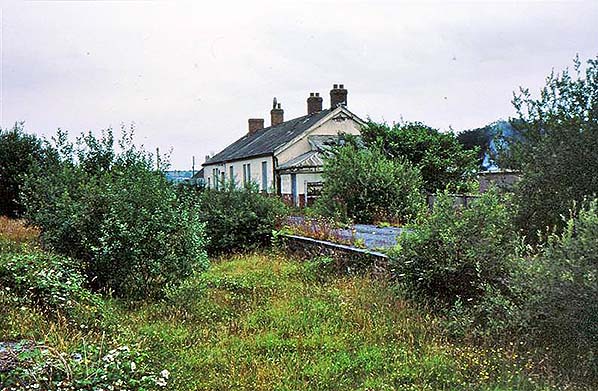 Halwill station down platform and station building seen from the by now heavily overgrown down
platform in 1980. Photo by Keith George Rose 3.jpg) Looking north at the Southern Railway slaughter house in September 1977, the replaced a smaller LSWR building. Locally produced meat was loaded into refrigerated containers for distribution by rail.The goods shed is behind the photographer.
Photo by Tim Miles 4.jpg) Halwill Station slaughter house in Spring 1985, the goods shed is seen beyond. The slaughterhouse was run by North Devon Meat, North Devon Meat, a farmers cooperative run by Dick Cawthorne.
Photo by Ron Strutt from Ron Strutt's Railway Photos web site 11.jpg) Halwill station building seen from the up platform in Spring 1985.
Photo by Ron Strutt from Ron Strutt's Railway Photos web site Click here for Halwill Gallery 8: Mid 1980s - October 2007 5.jpg) Halwill station booking office circa mid 1980s
Photo by Ron Strutt from Ron Strutt's Railway Photos web site 7.jpg) The path between the down platform and the Torrington bay platform circa mid 1980s
Photo by Ron Strutt from Ron Strutt's Railway Photos web site 8.jpg) Halwill goods shed circa mid 1980s
Photo by Ron Strutt from Ron Strutt's Railway Photos web site 9.jpg) Halwill Station forecourt circa mid 1980s
Photo by Ron Strutt from Ron Strutt's Railway Photos web site 10.jpg) Halwill Station looking north along the down platform circa mid 1980s
Photo by Ron Strutt from Ron Strutt's Railway Photos web site 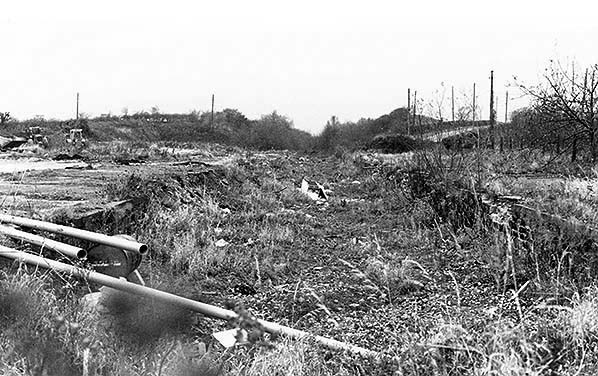
Halwill station looking north in November 1988. The station building has now been demolished and the heavy machinery seen top left suggests work is underway at the site.
Photo by John Mann 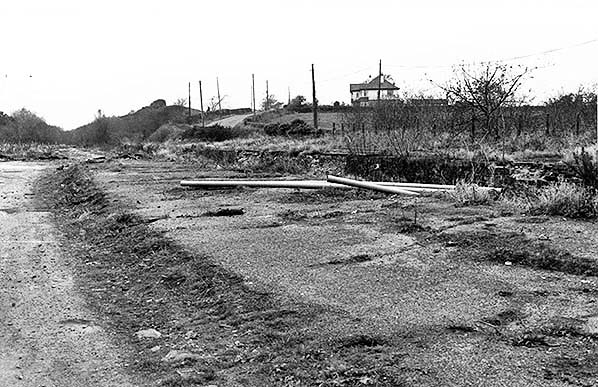 Halwill station looking north in November 1988; the down bay platform is seen in the foreground. All the edging has been removed prior to final clearance of the site.
Photo by John Mann 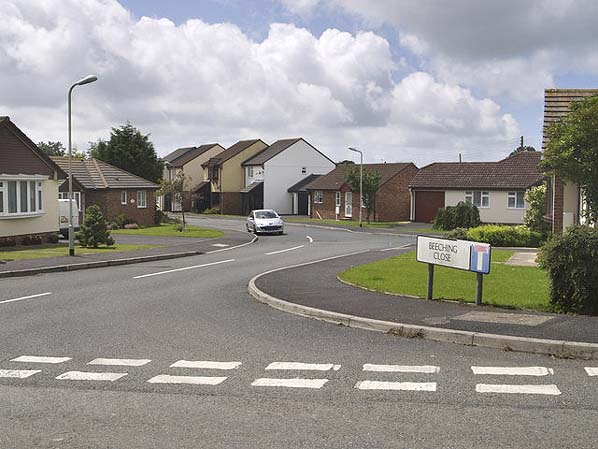 The site of Halwill station looking across the site of the platforms in July 2007. (see plan). The entrance to Beeching Close is roughly where the signal box was sited.
Photo by Derek Harper from Geograph reproduced under Creative Commons Licence 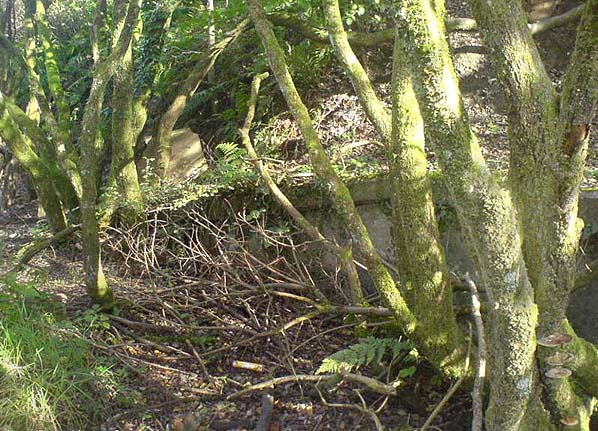
A section of the Torrington platform survives in the Halwill Junction Nature Reserve. The platform ramp is seen here In October 2007.
Photo by Jonathan Ritchie from his Lost Railways Flickr photostream
Click on thumbnail to enlarge
|
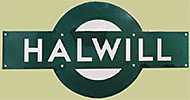
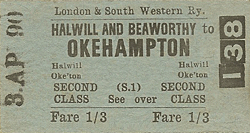
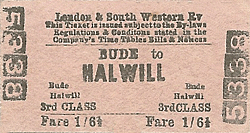 When Halwill became a junction with the opening of the North Cornwall line, a new large signal box was built on the up platform which controlled the junction and the new bay platform on the down side. In the down direction, the trackwork and signalling allowed a train to depart from the down platform towards Bude at the same time as a down train departed from the down bay over the North Cornwall line. In the up direction, there was an inner home signal which allowed up trains to be signalled into the bay. The latter signal was subsequently removed, however, and all up trains then arrived in the up platform.
When Halwill became a junction with the opening of the North Cornwall line, a new large signal box was built on the up platform which controlled the junction and the new bay platform on the down side. In the down direction, the trackwork and signalling allowed a train to depart from the down platform towards Bude at the same time as a down train departed from the down bay over the North Cornwall line. In the up direction, there was an inner home signal which allowed up trains to be signalled into the bay. The latter signal was subsequently removed, however, and all up trains then arrived in the up platform.
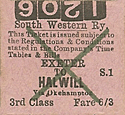 With the opening of the ND&CJLR in 1923, a new bay platform was added beyond the Bude end of the up platform which had no facilities at all - except for a running in board (which only ever showed Halwill) and a single bench seat. At the same time, the signal box was extended to accommodate extra levers - giving it an odd lop-sided look. The signal box now contained four single line token machines - the tokens being lowered to the platform by means of a bucket on a pulley!
With the opening of the ND&CJLR in 1923, a new bay platform was added beyond the Bude end of the up platform which had no facilities at all - except for a running in board (which only ever showed Halwill) and a single bench seat. At the same time, the signal box was extended to accommodate extra levers - giving it an odd lop-sided look. The signal box now contained four single line token machines - the tokens being lowered to the platform by means of a bucket on a pulley! 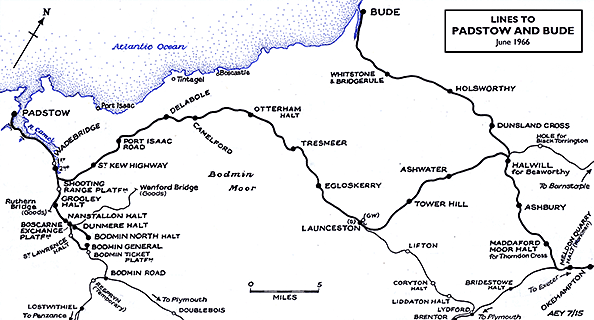
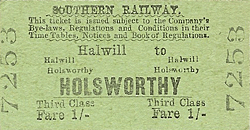 PASSENGER TRAINS
PASSENGER TRAINS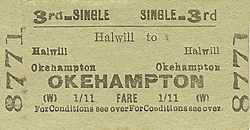 In BR days, there were four down trains over the North Cornwall line to Padstow plus one which only ran as far as Launceston. There were eight trains a day to Bude of which two started at Halwill. In the up direction there were four trains from Padstow and one from Launceston and six from Bude. On Sundays there were two trains to Bude and one to Launceston - largely to cover Royal Mail requirements.
In BR days, there were four down trains over the North Cornwall line to Padstow plus one which only ran as far as Launceston. There were eight trains a day to Bude of which two started at Halwill. In the up direction there were four trains from Padstow and one from Launceston and six from Bude. On Sundays there were two trains to Bude and one to Launceston - largely to cover Royal Mail requirements.
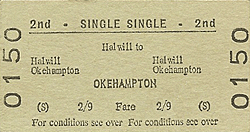 The ND&CJLR line only ever had two trains a day from Halwill to Torrington which departed at 10:38 a.m. and 6:30 p.m. On arrival at Halwill, the train - which normally consisted of a tank engine and single brake composite coach - had to reverse out of the bay platform to get to the run-round loop (which it had passed through on the way in). Having run-round its single coach, the loco backed the train into the bay platform once more ready for departure. Steam hauled trains through Halwill ceased from 1st January 1965 and the Torrington service was withdrawn on 1st March 1965. The last train through Halwill was on 1st October 1966 (a Saturday) with official closure from 3rd October.
The ND&CJLR line only ever had two trains a day from Halwill to Torrington which departed at 10:38 a.m. and 6:30 p.m. On arrival at Halwill, the train - which normally consisted of a tank engine and single brake composite coach - had to reverse out of the bay platform to get to the run-round loop (which it had passed through on the way in). Having run-round its single coach, the loco backed the train into the bay platform once more ready for departure. Steam hauled trains through Halwill ceased from 1st January 1965 and the Torrington service was withdrawn on 1st March 1965. The last train through Halwill was on 1st October 1966 (a Saturday) with official closure from 3rd October.
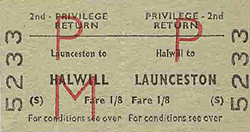 FREIGHT
FREIGHT
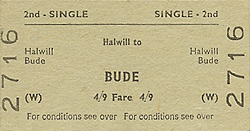 There are plans to further increase the cycle network by reopening the section east towards Meldon Junction. In 2005 Devon County Council agreed in principle to the creation of a bridleway on an intact disused section of the Bude Branch from Thorndon Cross (near the former Meldon Junction) and Halwill, a distance of approximately 7 miles. The proposal has made slow progress in the face of objections from local residents and the prohibitive prices demanded for the sale of their land by trackbed owners. In 2007 the Council again reiterated its intention to convert the disused railway to public amenity, reaffirming its intention to create cycleways on the sections from Bude to Halwill and Torrington to Halwill.
There are plans to further increase the cycle network by reopening the section east towards Meldon Junction. In 2005 Devon County Council agreed in principle to the creation of a bridleway on an intact disused section of the Bude Branch from Thorndon Cross (near the former Meldon Junction) and Halwill, a distance of approximately 7 miles. The proposal has made slow progress in the face of objections from local residents and the prohibitive prices demanded for the sale of their land by trackbed owners. In 2007 the Council again reiterated its intention to convert the disused railway to public amenity, reaffirming its intention to create cycleways on the sections from Bude to Halwill and Torrington to Halwill.
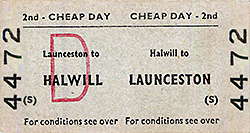
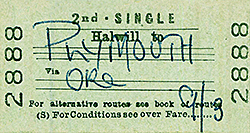
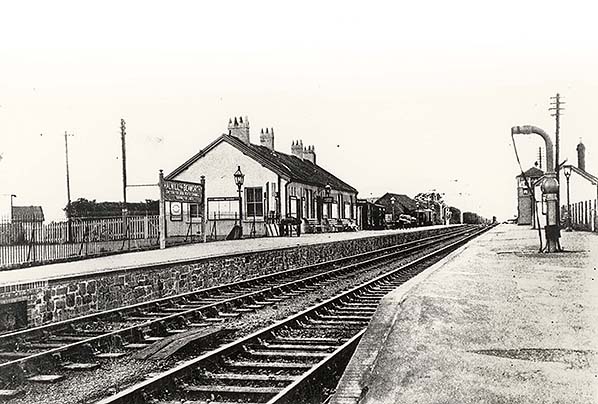 A view, probably from a postcard, looking north along Halwill's up platform. If it were not for the noticeboard on the side of the station building being headed ' Southern Railway', it would be difficult to allocate a period to this view. We can date it to the 1931 - 1940 period as one photograph with a known date of 1931 (above) showing oil lighting, as seen here, still in position and this was replaced by electric lighting sometime during that decade and possibly in 1935 as the Southern undertook a number of such modernisations during the year. Of possible interest to modellers might be the water column on the right, complete with brazier to prevent freezing during the winter. The lower section of the column is quite ornate but the overall appearance is rather ugly. Later this column was either modified or replaced, it is unclear which, and ended up even more hideous while in later years it had come to lean very noticeably towards the platform edge. Water columns, or water cranes if a moveable boom was fitted, were of course functional devices but nevertheless many, especially the crane type, had a certain charm about them. Many remained in use beyond the end of steam in some areas due to the need to replenish the steam heating boilers originally installed in main line diesel locomotives. Heritage railways excepted, a small number continue in use today at depots and servicing points which handle main line registered steam locomotives but otherwise they are relics of a bygone age.
A view, probably from a postcard, looking north along Halwill's up platform. If it were not for the noticeboard on the side of the station building being headed ' Southern Railway', it would be difficult to allocate a period to this view. We can date it to the 1931 - 1940 period as one photograph with a known date of 1931 (above) showing oil lighting, as seen here, still in position and this was replaced by electric lighting sometime during that decade and possibly in 1935 as the Southern undertook a number of such modernisations during the year. Of possible interest to modellers might be the water column on the right, complete with brazier to prevent freezing during the winter. The lower section of the column is quite ornate but the overall appearance is rather ugly. Later this column was either modified or replaced, it is unclear which, and ended up even more hideous while in later years it had come to lean very noticeably towards the platform edge. Water columns, or water cranes if a moveable boom was fitted, were of course functional devices but nevertheless many, especially the crane type, had a certain charm about them. Many remained in use beyond the end of steam in some areas due to the need to replenish the steam heating boilers originally installed in main line diesel locomotives. Heritage railways excepted, a small number continue in use today at depots and servicing points which handle main line registered steam locomotives but otherwise they are relics of a bygone age.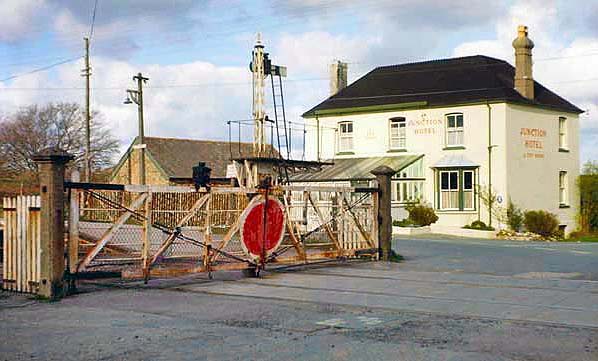 A pleasant view over Halwill level crossing, let down only by the somewhat scruffy condition of the gates, looking towards the Junction Hotel. There were four gates arranged as two pairs, with the keepers' hut located just off the picture to the left. No confirming details have come to light but the likely situation was the gates being interconnected in pairs so as one gate was swung a linkage swung another simultaneously. The lattice post signal is the Halwill up starter. It is rather close to the gates, a not untypical LSWR feature, which may explain why the gates were apparently opened to the railway some time before a train was ready to depart. Train drivers were and are highly skilled people and not in the habit of over-running signals (known today as SPAD - Signals Passed At Danger) but it did and does happen from time to time and demolished level crossing gates were not unknown. Regulations required that signals could not be set to 'off' when gates were closed to the railway and this was achieved by interlocking. At Halwill, the crossing keepers' hut would have been linked to the signal box for this reason. Generally the small pedestrian gates either side of a level crossing would also be interlocked so they could not be opened when a train was due. Although this view is colour, it is difficult to date as they are no clues such as road vehicles visible. However, difficult to see here but visible on a larger version are television aerials on the left chimney stack of the Junction Hotel. BBC television did not become available in this area until 1956, from North Hessary Tor transmitter, with UHF arriving in 1964 from the then also new Redruth transmitter. The aerials on the hotel appear to include a UHF example, if so the earliest date for this photograph would be 1964. The hotel still trades today and is now known as the Junction Inn. Little information on the building's history appears to be available in the public domain but we can assume its existence was due to the arrival of the railway at Halwill.
A pleasant view over Halwill level crossing, let down only by the somewhat scruffy condition of the gates, looking towards the Junction Hotel. There were four gates arranged as two pairs, with the keepers' hut located just off the picture to the left. No confirming details have come to light but the likely situation was the gates being interconnected in pairs so as one gate was swung a linkage swung another simultaneously. The lattice post signal is the Halwill up starter. It is rather close to the gates, a not untypical LSWR feature, which may explain why the gates were apparently opened to the railway some time before a train was ready to depart. Train drivers were and are highly skilled people and not in the habit of over-running signals (known today as SPAD - Signals Passed At Danger) but it did and does happen from time to time and demolished level crossing gates were not unknown. Regulations required that signals could not be set to 'off' when gates were closed to the railway and this was achieved by interlocking. At Halwill, the crossing keepers' hut would have been linked to the signal box for this reason. Generally the small pedestrian gates either side of a level crossing would also be interlocked so they could not be opened when a train was due. Although this view is colour, it is difficult to date as they are no clues such as road vehicles visible. However, difficult to see here but visible on a larger version are television aerials on the left chimney stack of the Junction Hotel. BBC television did not become available in this area until 1956, from North Hessary Tor transmitter, with UHF arriving in 1964 from the then also new Redruth transmitter. The aerials on the hotel appear to include a UHF example, if so the earliest date for this photograph would be 1964. The hotel still trades today and is now known as the Junction Inn. Little information on the building's history appears to be available in the public domain but we can assume its existence was due to the arrival of the railway at Halwill.
old_thumb5.jpg)
old_thumb4a.jpg)
old_thumb7.jpg)
thumb6.jpg)
thumb15.jpg)


 Home Page
Home Page